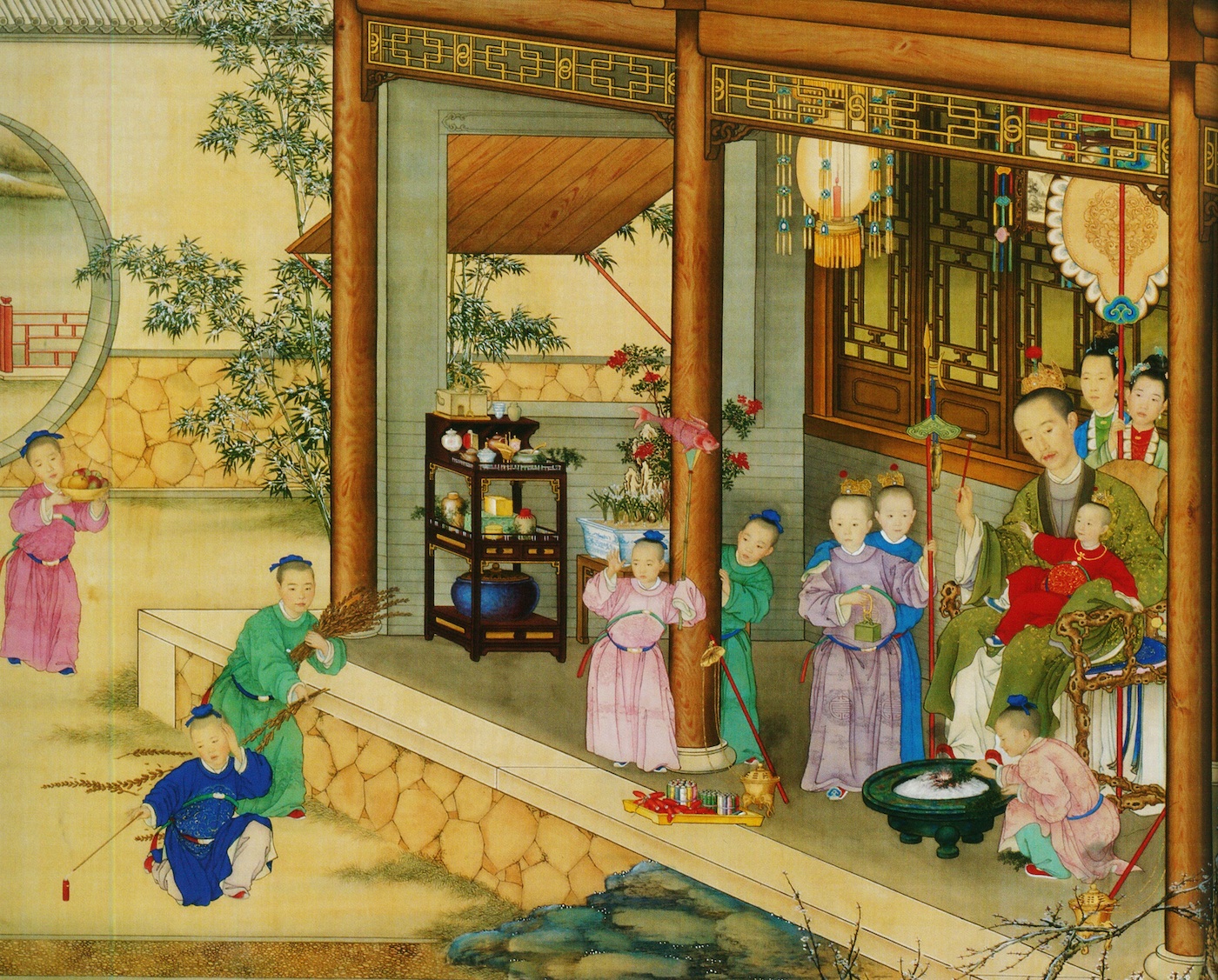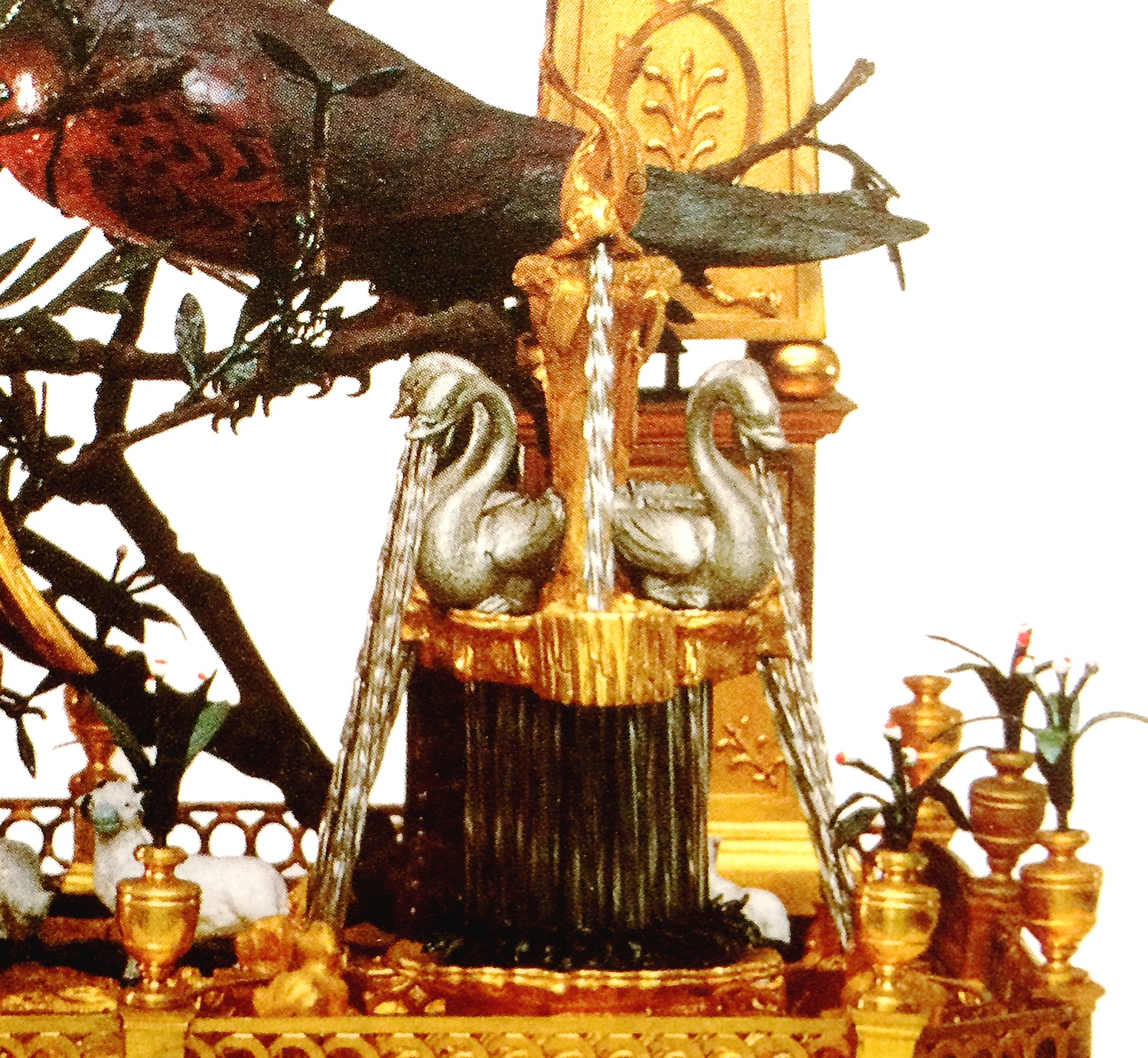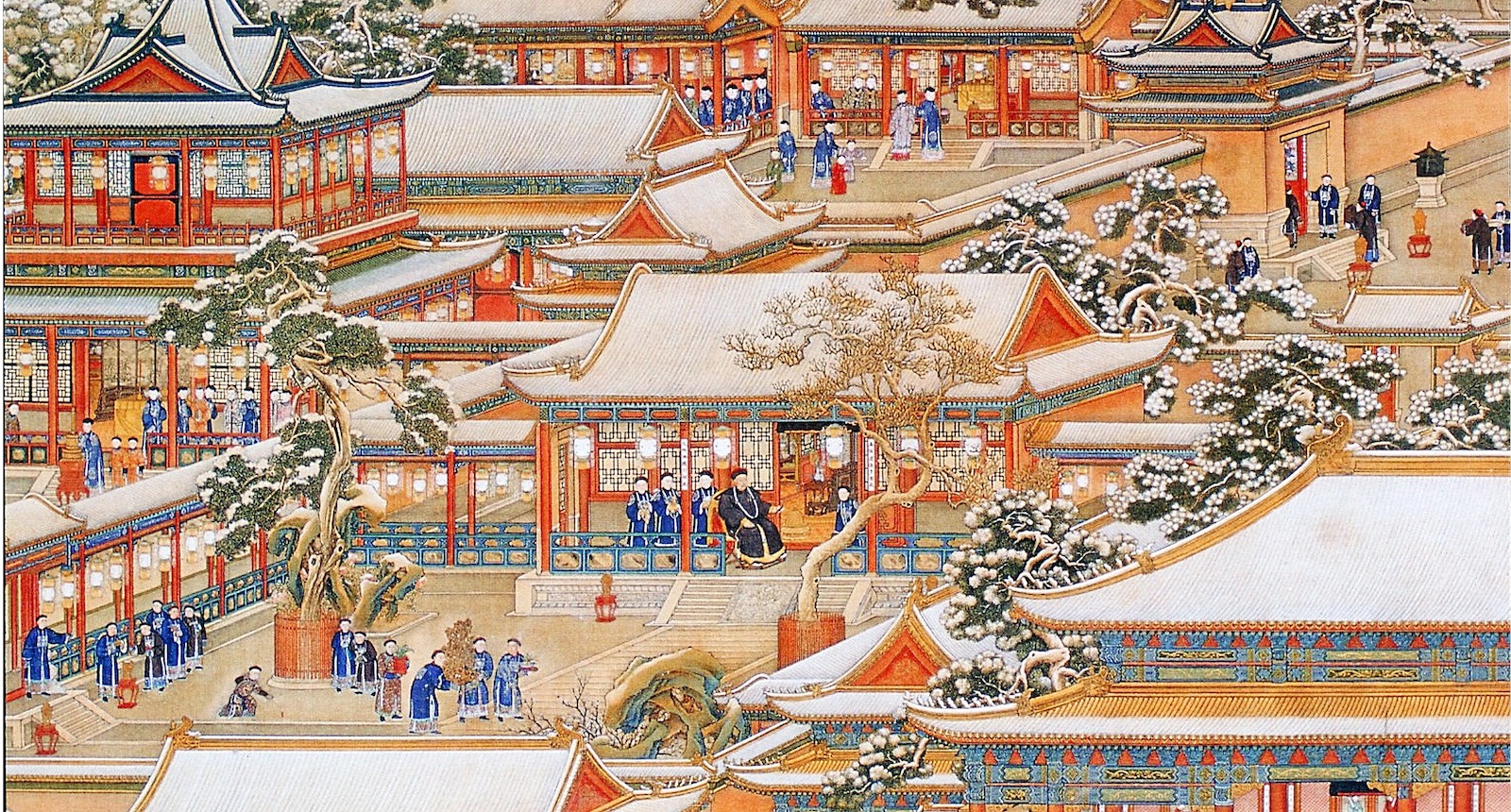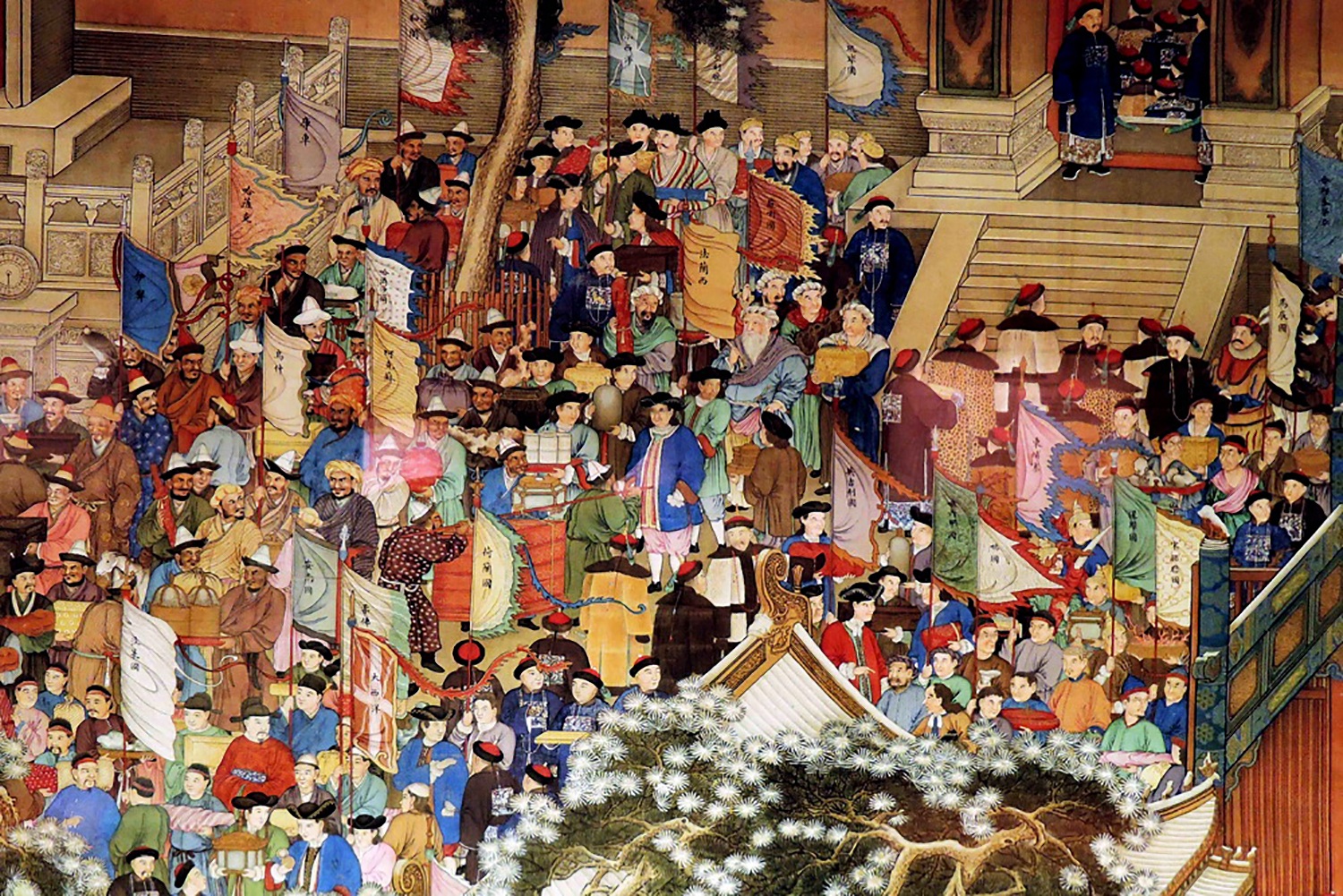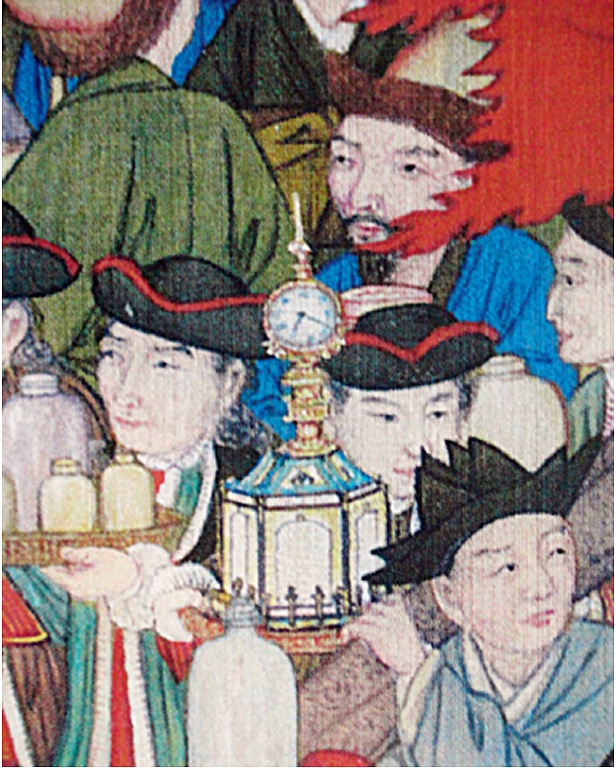Lihong Liu
Fireworks in the early modern world paradoxically wedded a local experience of ephemeral sensations with an impulse to create patterns of perpetual motion. Exploring the custom of fireworks in China alongside their pictorial representations and decorative applications in a transcultural context during the long eighteenth century, this article draws connections among various artifacts that enacted pyrotechnic spectacles and elicited synesthetic immersions of light, sound, motion, hue, and temperature. It opens up a broader discussion regarding the conceits and sensations of pyrotechnics and pyropolitics, while also responding to recent accounts of early modern European pyrotechnic arts and sciences.[1]
I argue that fireworks not only engaged in redefinitions of art and power, but also that the lifelike simulation of pyrotechnic effects in objects such as automaton clocks transformed conceptions and strategies of ornamentation. When activated alongside other movable accessories on mechanical clocks, firework ornaments highlighted a sense of synchronic time and fueled the vigor of temporal imminence. They acted out a spectacle of power that was manifested in an illusory unity of variations governed by the workings of an automatic system.[2] As mechanical clocks became the most salient objects and technologies of Sino-European exchange, flourishing especially during the High Qing era (1661-1796), such effects generated a sense of spatiotemporal profusion. This idea was demonstrated in the time-honored themes, syncretic compositions, and spectacular abundance of artifacts commissioned and collected at the Qing court and intended to resound with the panoptic ordering of imperial power.
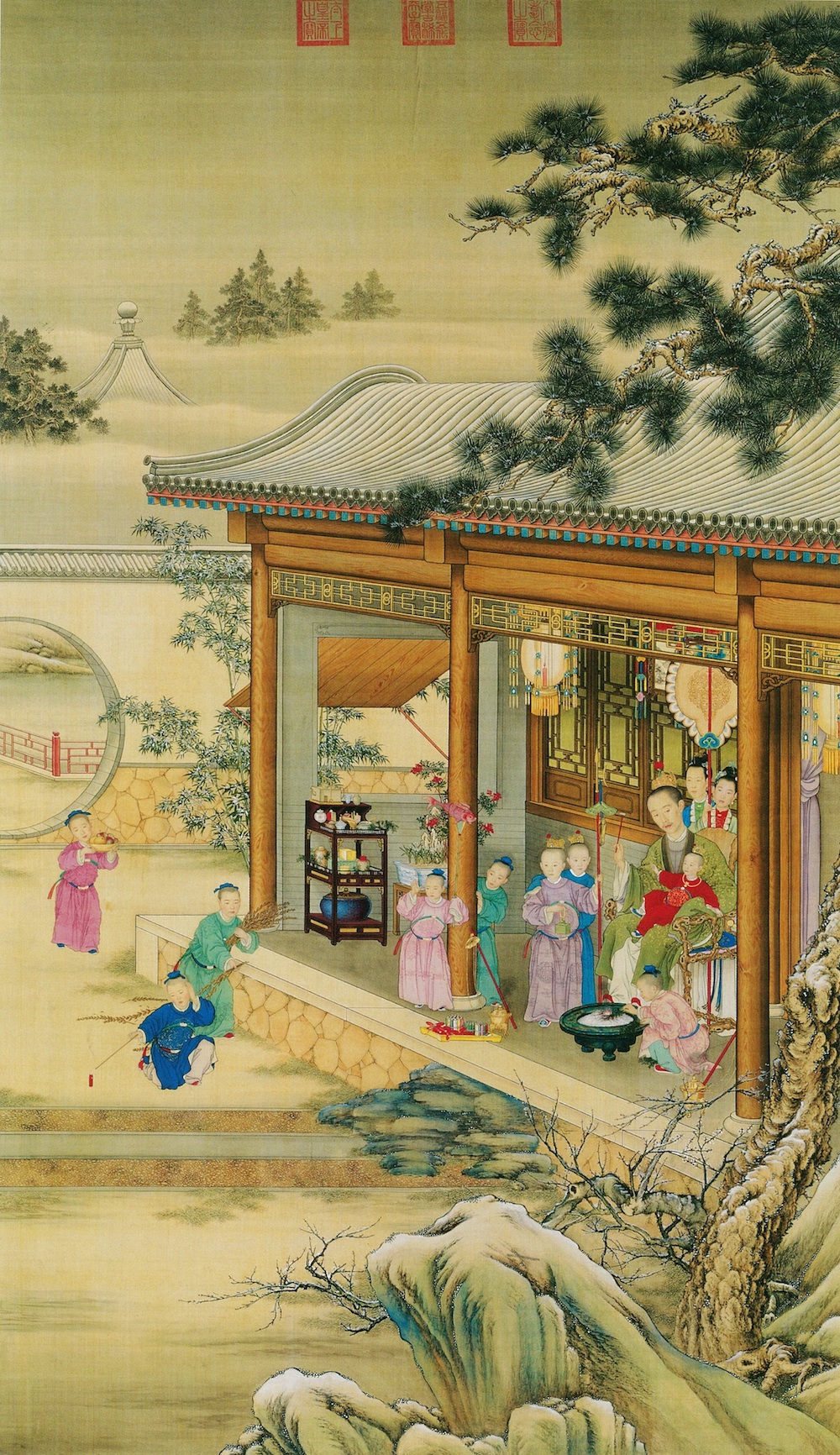
Fig. 1. Giuseppe Castiglione, Tang Dai, and Chen Mei, New Year’s Beginning, 1736. Hanging scroll, color on silk, 277.7 x 160.2 cm. Palace Museum, Beijing. Image in the public domain.
Ignition in the New Year’s Beginning
At the end of 1736, the newly-enthroned Emperor Qianlong (r. 1735-1796) commissioned the painting New Year’s Beginning (Sui zhao tu 歲朝圖) (Fig. 1). This was the product of collaboration between the three major court painters of the day: the Italian Jesuit-missionary artist Giuseppe Castiglione (1688-1766), the Manchu bannerman official-painter Tang Dai 唐岱 (1673- after 1752), and the southerner Chinese painter Chen Mei 陳枚 (ca. 1694-1746). In a distinctive Qing court style combining European perspective with the finely modulated brushwork and ink gradations of the Chinese jiehua 界畫 tradition (painting using a ruler), the celebratory scene depicts a moment of excitement.[3] Seated placidly in a rootwood chair in a veranda in the imperial garden, the emperor’s positioning contrasts with another center of attention in the composition: on the ground, a boy is igniting a firecracker (Fig. 2). These dual foci are connected by the relay of gestures and gazes among the surrounding nine young boys and two palace women. While Qianlong holds a hammer in his right hand, ready to strike the chime, he turns his gaze toward the toddler in his lap who reacts to his action. The toddler, two-year-old Yongzhang 永璋 (1735-1760), wears a crown that indicates his status of immediate kinship with Qianlong and the two boys next to him. The seven-year-old Yonglian 永璉 (1730-1738), recently designated (covertly) by the emperor as heir-apparent, holds the stone chime upright.[4] The chime is hung on a halberd that symbolizes the state. Yonglian’s right hand holds a seal, signifying authority. Qianlong’s act of “striking the chime” (jiqing 擊罄), while invoking an archaic stately ceremony, is a pun on the phrase “auspicious celebration” (jiqing 吉慶). Thus, with its stylistic fusion, archaic theme, and simultaneous actions, this scene of private familial amusement proclaims several beginnings: the New Year, the new era, and the emergence of an heir-apparent.
The impending sound of the chime anticipates a combusting echo from the firecracker a few feet away. Down in the yard, a boy in an indigo-blue robe stretches out a burning straw towards the firecracker, while his left hand covers his ear. Behind him, another boy in a turquoise robe brings additional stalks for ignition, and more firecrackers sit in a tray on the edge of the veranda. The source of the fire seems to be the scorching charcoal in the bronze firepan in front of the emperor, against which he rests his feet to feel the warmth. A boy is poking the fire with a pine branch, one of several gathered by his feet. Burning these fresh, medicinal pine branches generates a favorable smell and loud cracks due to their oily juice. Prince Yonghuang 永璜 (1728-1750), who embraces the heir-apparent like a brother from behind, looks at the firepan and seems startled by the burning. Near the firepan are two portable gilded hand-warming burners. Above, candles flicker in the lanterns hung on the eaves.
Contrasting with these swells of warmth and exhilaration are the frosty and calm surroundings. In the foreground, boulders obliquely point toward the firecrackers, while the gnarled trunk of an old pine winds upward in alignment with the pillars flanking the emperor. Covered in ice, the boulders and the pine serve as a wintry prelude to the fiery scene behind. The orthogonal lines of the pavilion diagonally recede into the rear of the garden, projecting into the deeper background. The half-cropped moon door reinforces the connection between background and foreground, particularly since a pink-robed boy carrying a fruit platter seems to have just walked through it. Above the roof, the pine tree curves back to embrace the nestled group of the family; it also corresponds to the treetops that emerge from the mist in the distance. Maximizing the pictorial space, the composition aptly frames the intimate ritual of the royal family as it celebrates the yearly cycle—a scene of happiness and prosperity meant to exemplify that of a myriad other households within the empire. The scene presents a spectacle of actions, a staged performance animated by heat, sound, and color. The deeply saturated, polychromatic hues of the firecrackers in the tray at the center project onto the actors’ garments and bring their movements to life against the comparatively austere tones of their surroundings.
Seizing upon a dramatic moment of blast and bang, the painting also stages the longstanding Chinese tradition of festive firecracker-playing. Here, the Manchu-Qing emperor’s maintenance of that tradition displays the exemplarity of the royal household to his diverse populations. Originating as nomadic tribes of multi-ethnogenesis in the Northeast, the Manchus conquered the Ming dynasty (1368-1644) ruled by Han-Chinese, and subsequently expanded the Qing empire to include poly-ethnic/religious groups including Mongols, Tibetans, Muslims, and Tartars. Therefore, representing those time-honored Chinese royal rituals was a vital means for the Manchu-Qing court to reinforce their ruling legitimacy.
As early as the Zhou dynasty (1046-256 BCE), igniting fires in the courtyard emerged as a royal and resolute act. Called “burning in the yard” (tingliao 庭燎), various flammable things were bundled together and burned in order to brighten the nocturnal murkiness and expel malign forces.[5] By the Han dynasty (206 BCE-220 CE), bonfires had become spectacles of New Year festivities, usually unleashed on the first day of the first month in order to inaugurate a healthy and auspicious year ahead. Presumably, the bonfire’s association with wellness coincided with the use of fire in medical sanitization in ancient China. For the same reason, it is said that during the Tang dynasty (618-907), Li Tian 李畋 (b. 621) invented “shattering bamboo” (baozhu 爆竹) by filling bamboo tubes with saltpeter and covering them with pine oil, which exploded the tubes upon lighting. This creation likewise aimed to repel “ominous vapor” (zhangqi 瘴氣), a cause of plague at the time. Other recipes and methods continued to develop and eventually culminated in the invention of gunpowder (huoyao 火藥, literally “fire drug”) in the mid-ninth century.[6] During the Song dynasty (960-1279), with advances in science and technology, gunpowder ushered China into a new age of weapons manufacture and entertainment ventures. With the advent of gunpowder battles around 1000,[7] paper-rolled gunpowder firecrackers (baozhang 爆仗) became popular.[8] These innovative techniques extended the “shattering bamboo” tradition but achieved stronger effects and greater efficiency by wrapping a powder core in tightly rolled papers with an exposed fuse—hence the typical firecracker that would survive into the Qing dynasty, as shown in the above-mentioned painting.[9]
In order to produce effects of whipping blasts or dramatic sparks, firecrackers were packed in specific ways. By weaving their fuses or bundling them as a roundel, for instance, one made a type called the “whipping/weaved firecracker” (bianpao 鞭/編炮). These seem to be the firecrackers depicted in New Year’s Beginning, suggesting that the subsequent cracks in the scene would be breathtakingly rattling. As firecrackers were consistently used in celebrations to illuminate, awaken, and propel blissful forces, the painting’s representation of this tradition proclaims the proliferation of a prosperous royal lineage. Moreover, its declaration of Qianlong’s discreet designation of his heir-apparent Yonglian in that year comes to be seen and heard through the firecrackers’ blast. The image thus showcases a historic episode, and firecrackers animate it.
Pyrotechnics and Pyropolitics: Ablaze Allover
Power and pleasure characterized the double-edged force of gunpowder in warfare and in royal and civic celebrations. The invention of gunpowder, as well as its arrival in Europe (from China via the Arabs) during the thirteenth century, fostered the expansion of empires and reconfigured power dynamics across the globe.[10] During the early modern period, as European gunners were revolutionizing gunpowder in firearms and artilleries, fireworks emerged as a related practice that fostered the reciprocal understanding of science and spectacle.[11] By the seventeenth century, using fireworks in celebrations became pervasive across and beyond the European continent.[12] The annual Bonfire Night on the Fifth of November observed in Great Britain, for example, commemorated the deliverance of King James I (1566-1625) and Parliament from the Gunpowder Plot. On that very day of 1605, Guy Fawkes (1570-1606), one of the plotters, was arrested while guarding explosives beneath the House of the Lords.[13] Successive reenactments of this event juxtaposed gunpowder’s oscillation between dangerous destruction and rejoicing felicitation. An engraving representing the fireworks demonstration held at Nuremberg, Germany on June 22, 1665 underscores these two aspects of gunpowder on two registers of the picture (Fig. 3). The lower register contains firearms, artillery, fire wheels, etc., whereas the upper one features fireworks. The spatial depths of the two scenes seem to converge on a continuously recessive ground, but the literal elevation of the upper register doubles the ascending view of the fireworks that sprout into the dark sky and settle down into blossoms.
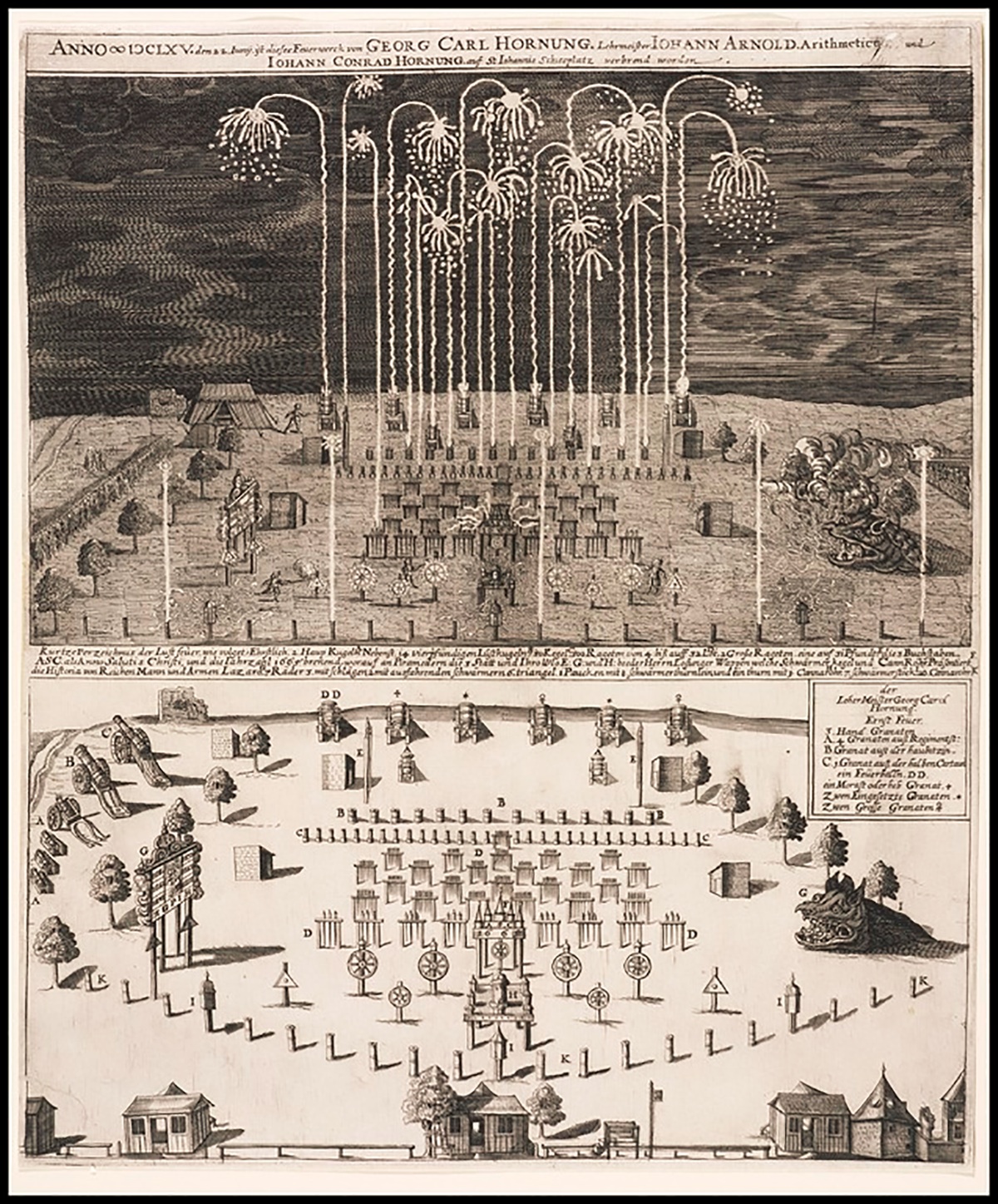
Fig. 3. Anonymous, Anno MDCLXV den 22. Iunÿ ist dieses Feuerwerck von Georg Carl Hornung Lehrmeister Iohann Arnold Artithmeticu und Iohann Conrad Hornung auf St Iohannis Schiesplatz verbrend worden, 1665 (?). Engraving, 36.6 x 30.4 cm. Getty Research Institute, Los Angeles. Digital image courtesy of the Getty’s Open Content Program.
Representations of this incendiary art—in drawings, engravings, optical devices, and other media—proliferated in early modern Europe, as shown in Kevin Salatino’s trailblazing study. By emphasizing the depiction of firework events, Salatino argues that the culture of fireworks manifested both political power and an aesthetics of the sublime. Fireworks, he argues, were considered analogous to narrative compositions, or tableaux that presented spectacles of action.[14] Such spectacles integrated firework explosions with their physical settings. Temporary or permanent structures erected on the ground, for example, were one typical visual anchor for staging fireworks, as seen in an engraving from around 1749 that represents a perspective view of a building for fireworks in London’s Green Park (Fig. 4). The implied tension between fleetingness and stillness holds together the vivid spectacle as a display of appearance and transcendence.
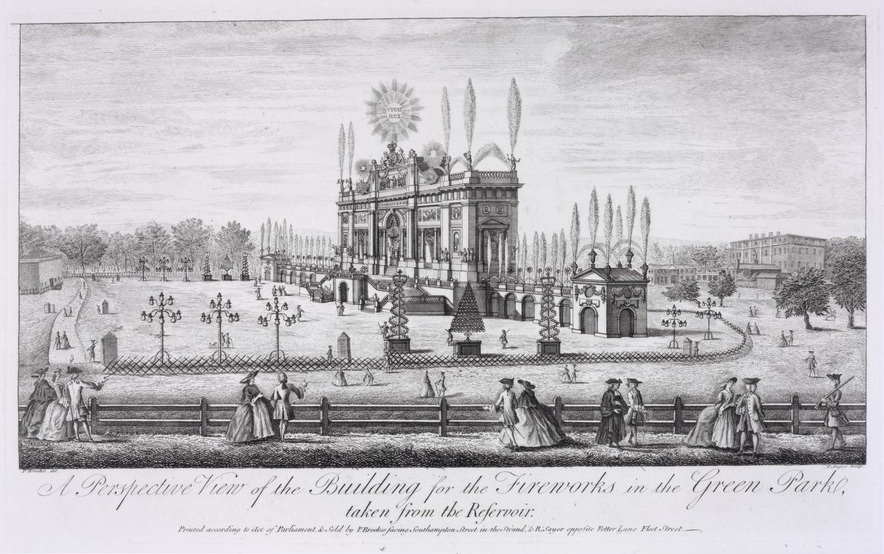
Fig. 4. Paul Angier after P. Brookes, A Perspective View of the Building for the Fireworks in the Green Park, Taken from the Reservoir, 1749 (?). Fireworks in London, April 27, 1749, in celebration of the Peace of Aix-la-Chapelle. Engraving, 37.8 x 55 cm. Getty Research Institute, Los Angeles. Digital image courtesy of the Getty’s Open Content Program.
Another distinctive locus for performing fireworks was by water. Simon Werrett suggests that staging fireworks over lakes and rivers engaged with a notion of contrasts, manifesting a “battle of elements.”[15] I would highlight the fact that the complementary forces between fire and water also lie in their contending and thus doubling spheres of illumination, which heightens the fluidity and metamorphosis of matter. Their luminosities astonishingly dramatize livelier effects of atmospheric transmutation in order to generate a deep and expansive swell of aquatic and fiery chorus. In 1685, fireworks celebrating the coronation of James II (1633-1701) of England (Fig. 5) were set above the Thames, giving rise to a choreography of explosions blooming in the air above the water, where fountains erupt and startled geese hustle. These actions in turn catalyze the undulation of the water waves, which compete in flashing splinters of light. All of these reciprocal and causal happenings create a spectacle of “splendid confusion,” which Edmund Burke invoked to describe fireworks.[16] Such spectacular confusion made pyrotechnic display a prime demonstrator of the sublime. As Burke explains, the sublime comprises intense feelings of danger and pain that could be transformed into delight through distance and other modifications.[17] The appearance of fireworks combined a sense of magnificence, infinity, and profusion with disorder and panic.

Fig. 5. Anonymous, A Representation of the Fire-works upon the River of Thames, over against Whitehall, at their Majesties Coronation Ao. 1685, c. 1685. Engraving, 44.0 x 52.3 cm. Getty Research Institute, Los Angeles. Digital image courtesy of the Getty’s Open Content Program.
The eighteenth-century idea of fireworks as a coordinated spectacle of actions—as shared by the composition of all the arts[18]—seems to have heralded Theodor W. Adorno’s famous analogy between fireworks and artworks. Adorno writes:
The phenomenon of fireworks is prototypical for artworks, though because of its fleetingness and status as empty entertainment it has scarcely been acknowledged by theoretical consideration…. It is not through a higher perfection that artworks separate from the fallibly existent but rather by becoming actual, like fireworks, incandescently in an expressive appearance. They are not only the other of the empirical world: Everything in them becomes other. It is this to which the preartistic consciousness of artworks responds most intensely.[19]
To Adorno, a work of art, like the workings of fireworks, exists in a “pregnant moment” where its appearance necessarily contradicts its existence, as every action within its becoming turns it into what it does not promise. Thus, the sublimation of art resides in a work’s alienation from its own appearance.

Fig. 6. Jean Le Pautre, Cinquiéme Journée Feu d’artifice sur le Canal de Versailles, 1676. From André Félibien, Les divertissemens de Versailles donnez par le roy a toute sa cour au retour de la conqueste de la Franche-Comté en l’année M.DC.LXXIV. Engraving, 41.5 x 48.8 cm. Getty Research Institute, Los Angeles. Digital image courtesy of the Getty’s Open Content Program.
Oscillating between power and pleasure, danger and delight, pyrotechnical displays were well suited to catalyze the political sublime. In them, monarchical presence departed from ordinary space and time to embrace the magnificent scales of being that would harness order in chaos. As Salatino argues with regard to a series of 1676 engravings depicting fireworks on the canal at Versailles (Fig. 6): “The principle of order was manifested in the person of the king. As such, Louis’s sun emblem not only identified him with the god Apollo, in a post-Copernican universe it also placed him firmly at the center, around which everything (and everyone) revolved.”[20] The rhetoric and sensation of hot waves, bright radiances, and revolving heavenly bodies (their orbits by then well known) together fueled the “pyropolitics” of the Sun King.[21] Fireworks precisely manifest the emblematic acts of scorching, radiating, and revolving, repetitively and episodically.

Fig. 7. Pierre d’Incarville (1706-1757), A Representation of Chinese Fireworks, 1763. Plate from English abstract of an account by d’Incarville published in 1764. Image source: Joseph Needham et al., Science and Civilization in China. Volume 5: Chemistry and Chemical Technology. Part 7: Military Technology: The Gunpowder Epic (Cambridge: Cambridge University Press, 1986), 142, fig. 12.
Later, the French Jesuit priest and botanist Pierre d’Incarville (1706-1757) would report from China in 1763 about the craze for pyrotechnic play and display in this land of gunpowder. His illustration of fireworks in eighteenth-century China exhibits two high floral combustions from earthenware pots, among other variants (Fig. 7).[22] In 1593, the Chinese official Shen Bang 沈榜 (1540-1597) had described such combustions and other varieties of fireworks in an entry titled “Discharging Fireworks” (Fang yanhuo放煙火):
[People] use crude iron powder to mix with saltpeter, sulphur, and charcoal, and so on in order to create playthings. Names vary: those which make a deafening sound are called “resounding bombs;” those which jet high up are called “ascending fires,” among which those that make serial resounding explosions in mid-air are called “three-tiered waves;” the ones that are dumb and do not jet but rush around on the ground are called “earth rats.” The construction of the playing scene should have contrasts between void and substantive spaces, and the division and distribution [of fireworks] should differ in their quantities. Therefore, those which manifest the shapes of flowers, grasses, people and things are called “patterning/floral blossoms” (hua’er)—which have names as many as hundreds. Otherwise, those sealed in a mud pot are called “earthenware pots;” those in a paper tube are “floral tubes;” those in a basket are “floral basins.” The generic term for all types is “fireworks” (yanhuo).[23]
Shen similarly emphasized the importance of the composition of the scenes with coordination and variation. The varieties expressed in his descriptive names were infinite, as the spectacles could represent innumerable views, both floral and figural.
An example of this idea can be seen in a woodblock print from the seventeenth-century Chinese novel The Plum in the Golden Vase (Jin ping mei金瓶梅) (Fig. 8). It shows figures playing with fireworks in front of a wealthy household during the Lantern Festival. Groups of people surround a wooden rack erected on an open ground; on the rack, different kinds of fireworks explode into a centrifugal floral pattern, emit starry fires, and flame steadily. As seen in this episode, the theatrical play of fireworks was often represented with spectators whose participatory actions and reactions fueled the incendiary vehemence of the spectacle. In reality, it drew beholders of all sorts, whose presence implied communal impact through contrived showcases of wealth and power. Yet the noises and views of fireworks in mid-air phenomenally transcended social boundaries to summon a convivial festivity of the event celebrated.

Fig. 8. Lanling Xiaoxiaosheng 蘭陵笑笑生, Illustration from The Plum in the Golden Vase (Jin ping mei金瓶梅), edition of 1628-1643, chapter 42 “Ostentatiously Playing Fireworks in front of the Gate of the Opulent Household,” pl. 705. Woodblock print. Image in the public domain.
Imperial spectacles featuring fireworks claimed to awaken and appease the universe before such audiences. In 1703, the newly elected Metropolitan Graduate Zha Shenxing 查慎行 (1650-1727) described one such performance after he was sent by Emperor Kangxi (r. 1661-1722) to watch fireworks in the Western Garden (Xi Yuan 西苑). He recalled how hundreds of racks of fireworks were erected and flamed on a vast open ground and the meteor-like fireworks were ignited from across the river. Then, “in a short while, near and far, fires and radiances symphonized in mid-air, as if the incipient spring-thunders were attacking the earth, flying lightning cracking the sky; simultaneously, the smoke utterly veiled the moonlight and sky, and the spectators became ecstatic and mesmerized, shocked and rocked, with a loss of self-control.”[24] Spectators’ experiences of psychosomatic transfixion and ocular hypnosis conformed to an imperial expression of cosmic might on such occasions. By the Qianlong’s reign, during New Year’s Lantern Festival, the court routinely held fireworks ceremonies in the Garden of Round Brightness (Yuan Ming Yuan 圓明園). The royal reception of courtiers, officials, and foreign dignitaries was set up on the expansive drill ground before the Pavilion of Lofty Mountains and Sinuous Waters (Shangao Shuichang Lou山高水長樓), surrounded by picturesque vistas. The ceremony contained a series of activities including banqueting, ritual, and martial and dramatic performances, before finally discharging fireworks to thrill the participants. Then, “the fire cords multiply and linger like soaring lightening; abruptly, one hears that as if ten-thousand bombs explode like thunders quake the sky, fleetingly.”[25] In those royal New Year ceremonies, fireworks’ emulation of celestial wonders assured imperial omnipotence.
The dramatic sound and sight of such spectacles earned them the name “fireworks drama” (huoxi 火戲), as Zhao Xuemin 趙學敏 (1719-1805) recorded in his treatise Summary of Fireworks Drama (Huoxi lue 火戲畧). Published in 1780, it was the most comprehensive technological account of fireworks to date. Hailing from Hangzhou, Zhao was a life-long local physician and alchemist. His treatise indicates that by the last quarter of the eighteenth century, extravaganzas involving fireworks had been widely practiced by well-off households in Southeastern China, among other regions. He writes:
Most recently [fireworks] have had the fullest range of exquisite and artful methods, numerous techniques contend with one another. During the Lantern Festival, the wealthy households build halls for this; they lay out racks on wide roads; the crowds fill the streets and applaud in the lanes. Suddenly, the lantern machineries lighten and brighten; floral flames compete for luminance; shooting stars fly high; and “earth rats” rush around.[26]
Zhao went on to describe spectators who looked up to appreciate fireworks or bent downward to retrieve their remnants; timid onlookers receded while brave ones leaned forward. Their thrilled and agitated noises corresponded to the beats of drums. “Enough to see in it the scene of a grand peaceful world, as if it is a splendid spectacle where soaring phoenixes congregate,” he marveled.[27] As discussed earlier, in New Year’s Beginning, Emperor Qianlong’s covert familial scene of playing with firecrackers evoked the yearly celebration of a common household. Here, Zhao’s description shows that comfortable local families emulated the grander spectacle of fireworks, which conjured and thus conveyed consonance with imperial visions of peace and prosperity.
Simulation, Synchronization, and Synesthesia: Firework Ornaments and Mechanical Clocks
If the fleeting and unstable appearance of fireworks made them a prototype for artworks in Adorno’s sense, the proliferation of their depiction in prints and other media raises the question of what “fireworks” meant for those “artefactual” artworks. Through this transfer, the ungraspable “pregnant moment” of art was transformed into frozen moments of calculated theatricality, and the spectacle of actions was reconfigured into a fixed view. In the above-mentioned engravings and in the painting New Year’s Beginning, although the sense of pyrotechnic incineration animated the worlds depicted, the visual scenes themselves were premediated. Such rationalizations served to endorse the artefactual reproducibility and profusion that the material mediums promised, which on a different level corresponded to the programmed and perpetuated impact of pyrotechnical play and display, as well as the cyclical commemoration and continuous affirmation of power and order.
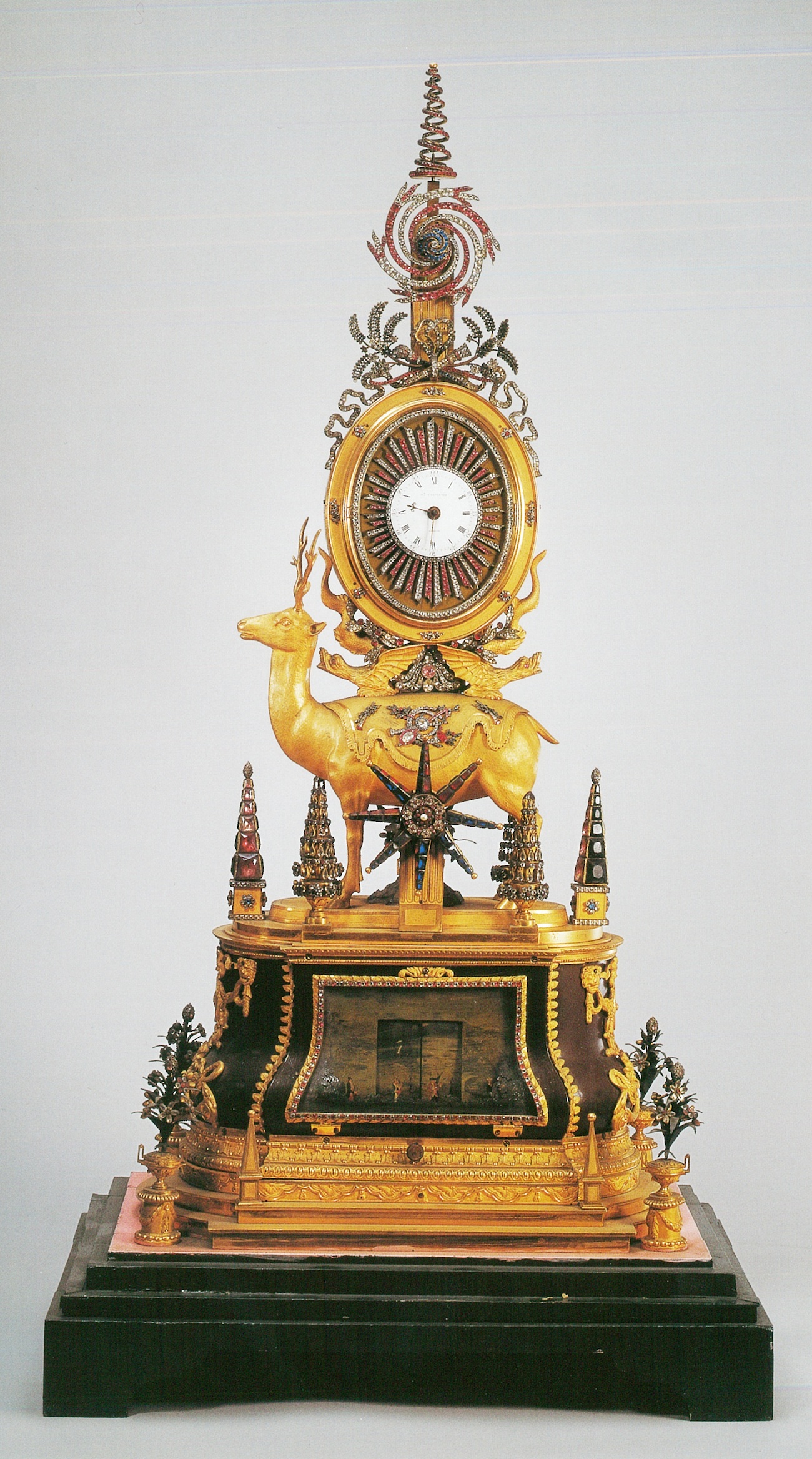
Fig. 9. William Carpenter (active 1770-1805). Gilded brass automaton clock on a wooden base, with firework ornaments. 96 x 29 x 45 cm. Palace Museum, Beijing. © Palace Museum.
Therefore, fireworks simultaneously provided conceits of ornamentation that contrarily made their incendiary apparitions contained, portable, and permanently displayable. Gusting, gushing, and glittering, the workings of fireworks made them both salient mobile ornaments and affixed patterns evoking motion, sound, radiance, and variation. Perhaps for this reason, early modern clockmakers favored firework ornaments on mechanical clocks, particularly in Britain, which united in one creation “Magnificence, Taste, Utility, and Delight.”[28] These ornaments especially permeated clocks made as elaborate gifts or commodities catering to Chinese consumers. Automaton clocks made by the company of William Carpenter (active 1770-1805) for the Chinese market, for example, are elaborately decorated with firework ornaments. One such clock, typically made of gilded brass on a wooden base, comprises a music box on its lower part containing the automechanism, while a stage and proscenium appear on its frontal surface (Fig. 9). Above, mystical animals uphold an oval roundel, amid which is a dial decorated with rays. The summit consists of a firework ornament with centrifugally curved stripes ending with patterns of sprouting flames, topped by cone-shaped spirals, all of which are made of colored bits of glass, as are the other accessories. The ornamental automata usually have a separate switch, independent of its function as a clock. When it is wound, melodies rise, the curtains of the proscenium open, and movable figures emerge. Simultaneously, the spirals spin at the top, while the miniature towers revolve and change color.
This centrifugal, floral and radiant ornament gave automaton clocks the effects of light and motion. Often such ornament actually revolved to simulate firework explosions and, in some cases, the shape of fire wheels that packed or racked fireworks (which in turn resembled the forms taken by their contents when activated) (Fig. 10). In another eighteenth-century English clock, a variety of firework ornaments appear: a floral vine sprawls around the dial, which is encircled by glass bits with green and red colors in an alternating sequence (Fig. 11). When winding up the automechanism, nine floral roundels on the music box revolve, simulating a tableau of firework explosions framed in a cartouche-like lozenge. Meanwhile, on the summit, mega “fireworks” gyrate with emanating dazzles. The summit consists of green and red layers of centrifugally curved structural lines, which would revolve in opposite directions around a floral centerpiece that mixes the colors of both. When revolving together, the apex turns into a fizzing ball.
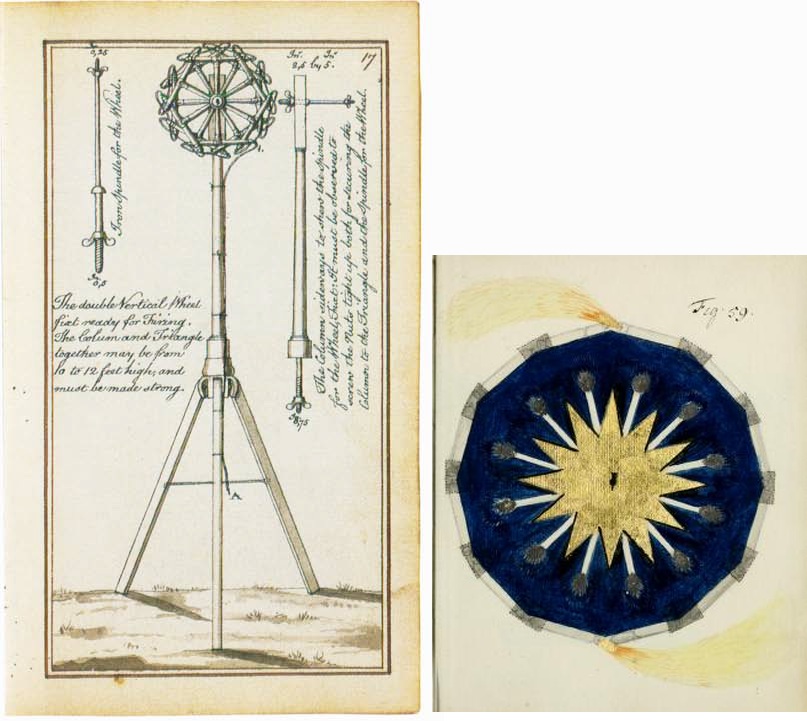
Fig. 10. LEFT: John Maskall, Artificial Fireworks, 1785. Manuscript (vol. 1, p. 17). Drawing with pen, brown ink with brown and gray wash, 17 x 11 cm. Getty Research Institute, Los Angeles, accession no. 920091. Image source: archive.org.
RIGHT: Large fire wheel. Graphite, watercolor, and gold leaf, 19.7 x 15.9 cm. From: “Beschrijving van kunst vuurwerken: zoo als dezelven zich in hunne uitwerkingen vertoonen: met CXIV uitvoerige teekeningen,” unpublished manuscript (fig. 59), c. 1780. Getty Research Institute, Los Angeles, accession no. 970037. Image source: archive.org.
The correlation between firework explosions and automata lies in their artificial organization that, when activated, aims to make manifest the inner vitality of matter and machine like that of the living organisms. Furthermore, the mechanization of fireworks within automata ornamentation intensifies the workings of these clocks whereby the volatility and imminent temporalities of fireworks become harnessed and regulated, demonstrating the governability of all things and processes under the automatic system.

Fig. 11. British clockmaker, Gilded brass automaton clock with firework ornaments made of colored bits of glass, eighteenth century. 56 x 22 x 16 cm. Palace Museum, Beijing. Image source: Gugong bowuyuan 故宮博物院, ed., Gugong zhongbiao 故宮鐘表 (Beijing: Zijingcheng chubanshe, 2004), p. 147.
These characteristics corresponded to the newly developed technologies of domestic mechanical clocks in early modern Europe, following the introduction of the spring drive around 1500 and the invention of the pendulum clock in 1657, which superseded the more weight-driven clock towers and bells invented around 1300.[29] Their hourly and resounding timing, together with their precision of subdivided quarters, minutes, and seconds, changed people’s consciousness of routine and social interaction.[30] Mechanical clocks embodied what Otto Mayr calls “the authoritarian conception of order” by enforcing routine across society.[31] Synchronization of actions on social and hierarchical scales disciplined people’s activities and instantiated a new sense of collective simultaneity. Concretely, here, the sense of simultaneity is manifested in the motions of firework ornaments alongside other accessories, as well as in their syncing with, and/or simulation of, the spring drives of mechanical clocks, in addition to their correspondences with the appearances and workings of the dials. The dials click with a weak sound rhythmically, reminding people of the fleetingness and immanence of time’s passing. Once their rotation reaches the full cycle of an hour, the clock “sings” gleefully and melodically, rendering a celebratory sense of fulfillment and an urge to pause before moving on.
In his study of automata as a fundamental conception of Enlightenment science and culture, Simon Schaffer notes that an “automatic system” in eighteenth-century Europe mediated the mutual emulation between man and machine as disciplined productive bodies. Automata that united philosophical, political, and scientific views on humans and machinery were thus not only metaphors of social order, but also became appealing commodities that manifested the expansion of human will through the animal economy of the machine. The techno-politics of order and freedom gained automata an important place at court, in the theatre, in consumer culture and in civic rituals.[32] As Schaffer points out, it is no coincidence that the political instrumentalization of automata, as well as courtly ritual, went hand in hand with the development of mechanical clocks, with rulers such as Louis XIV fostering mechanized court ceremonies by 1700.[33] Schaffer goes on to state that the late Enlightenment experienced the absolutist intensification of power, which put subjects in the positions of governed machines while fetishizing illusory marvels in an “occultist culture of the spectacle.”[34]
Accessorizing firework ornaments on mechanical clocks highlighted cyclical emergences and synchronic actions, on the one hand, and amplified the amazement of the automaton machine, on the other. Firework ornaments also stimulated synesthetic ambiences, afforded by the conceits and sensations of pyrotechnic hues, glows, sounds, and motions, which enhanced the machine’s liveliness and vivacity. Pyrotechnic synesthesia was deployed to describe the sounds of mechanical clocks. In 1663, the Portuguese Jesuit missionary Gabriel de Magalhães (1609-1677) presented a clock to Emperor Kangxi, which was described as follows: “After it rings at every hour, it plays a melody which differs each time; upon its ending, the sounds thunder like the chorus of ten-thousand bombs, and then gradually abate as if ebbing into the distance until diminished.”[35] Correspondingly, the hourly sounding of the clocks created fleeting spectacles just as fireworks did. In commenting on the musical sounds of the clock in the Catholic Church in Beijing, Father Ferdinand Verbiest (1623-1688) writes:
“I cannot describe how the novelty of this contraption enraptures the mind of the spectators, even to the extent that the square in front of our church, although it is very spacious, cannot hold the crowd that flocks together in thick and disorderly waves, so that our church and the square, especially on certain public holidays, is filled every hour with always different sightseers who succeed one another like ebb and flow.”[36]
Verbiest went on to contemplate the religious genuflections the onlookers felt from the melodious sounds. The ecstasy and awe likened what they would feel with fireworks’ forces.
Singing was a key part of such objects’ appeal. Called in Chinese “self-singing bell” (ziming zhong 自鳴鐘), mechanical clocks ushered Jesuit missionaries into mainland China.[37] In 1579, when Father Michele Ruggieri (1543-1607) arrived at Macao, he gave European clocks to a Guangzhou military official, which sparked the interest of the Chinese. Ruggieri advised the Order in Rome to have missionaries bring gifts to China, especially clocks. In 1582, Matteo Ricci arrived in China with such gifts and, in 1601, he was finally able to present them to the Ming dynasty Wanli Emperor (r. 1572-1620), who particularly liked receiving clocks. In 1652, Ricci’s successor Johann Adam Schall von Bell (1592-1666) presented to the Qing Shunzhi Emperor (r. 1643-1661) an automaton clock with a built-in revolving Sun and Moon representing Copernican knowledge of the heavenly bodies.[38] It has been a well-contested argument that European mechanical clocks were of such great interest to the Chinese that the Jesuits used them to infiltrate the court and the upper echelons of society for the next two centuries.[39] Although the Chinese astronomer Su Song 蘇頌 (1020-1101) had constructed an astronomical clock tower as early as 1088, European mechanical clocks fascinated the Chinese with their precision as well as their sounds and automata.[40]
In tandem with other early modern European innovations and whimsies, the designs of those clocks that aimed at attracting this new audience were often tinted with a presumed “Oriental” taste. A clock made by James Cox (ca. 1723-1800), for instance, conspicuously displays chinoiserie motifs and decorative strategies by incorporating firework ornament into a bird cage—a signature plaything in Qing aristocratic circles (Fig. 12). A small dial is built on the front side of the music box, here functioning as the base of the cage. Twelve pineapple trees (an exotic species brought by the Portuguese to China around 1600) fortify the fences of the cage. They also serve as columns to formulate a series of “doors,” laying out the architectonic “ground” of the scene to support the ascendance of the revolving firework ornament on the summit. With radial rays, such “fireworks” fiercely “explode” after sprouting sinuously along the fencework of the cage. As the fireworks blaze above, a bird inside the cage would tweet in song while it jumps back and forth between two poles leveled by a gilded conic cylinder. The cylinder would then open to showcase the surging “fountains” inside, composed of twisted glass rods.

Fig. 12. James Cox, Gilded brass automaton clock in the shape of a birdcage, with firework ornament on the summit, 18th century. 76 x 32 cm. Palace Museum, Beijing. Image Source: Gugong bowuyuan, ed., Gugong zhongbiao, p. 146.
Indeed, the construction of automaton clocks variously synthesized the conceits of fireworks, fountains, and birdsong so that the spectacle of their display imbued interior spaces with open-air ambiences. An English clock produced by Joseph Williamson (active 1710-1720) presents a pleasure garden tableau comprised of these elements (Fig. 13). Above the hexagonal music box—here like a hedged plot—the dial sits in the middle crowned by a gilded pheasant, surrounded by trees and singing birds (orioles, sparrows, and pigeons). Beside them, two fountains boost aqua-conduits: “water” cascading around pedestals, sprouting from the mouths of geese and fishes, and surging as waves underneath. Behind, bouquets rest atop two obelisks; on the upper front face of each obelisk are three firework ornaments varying in size and pattern. When the automechanism is wound the “water” flows, the “fire” blazes, and the birds “tweet.” Meanwhile, one can glimpse pastoral scenes on the “ground” level alongside a pleasant lifeworld where fanciful and chromatic birds hum, painted in vitreous enamels and framed in oval openings on the front and back sides of the music box. The “water,” made of twisted glass rods, was the most novel innovation on an automaton clock at that time (Fig. 14).[41] When the rods spin, their prismatic refractions of light in motion simulate water beams, cascades, and waves. The sparks of water and fire, made respectively of crystalline and colored glass, illuminate each other.
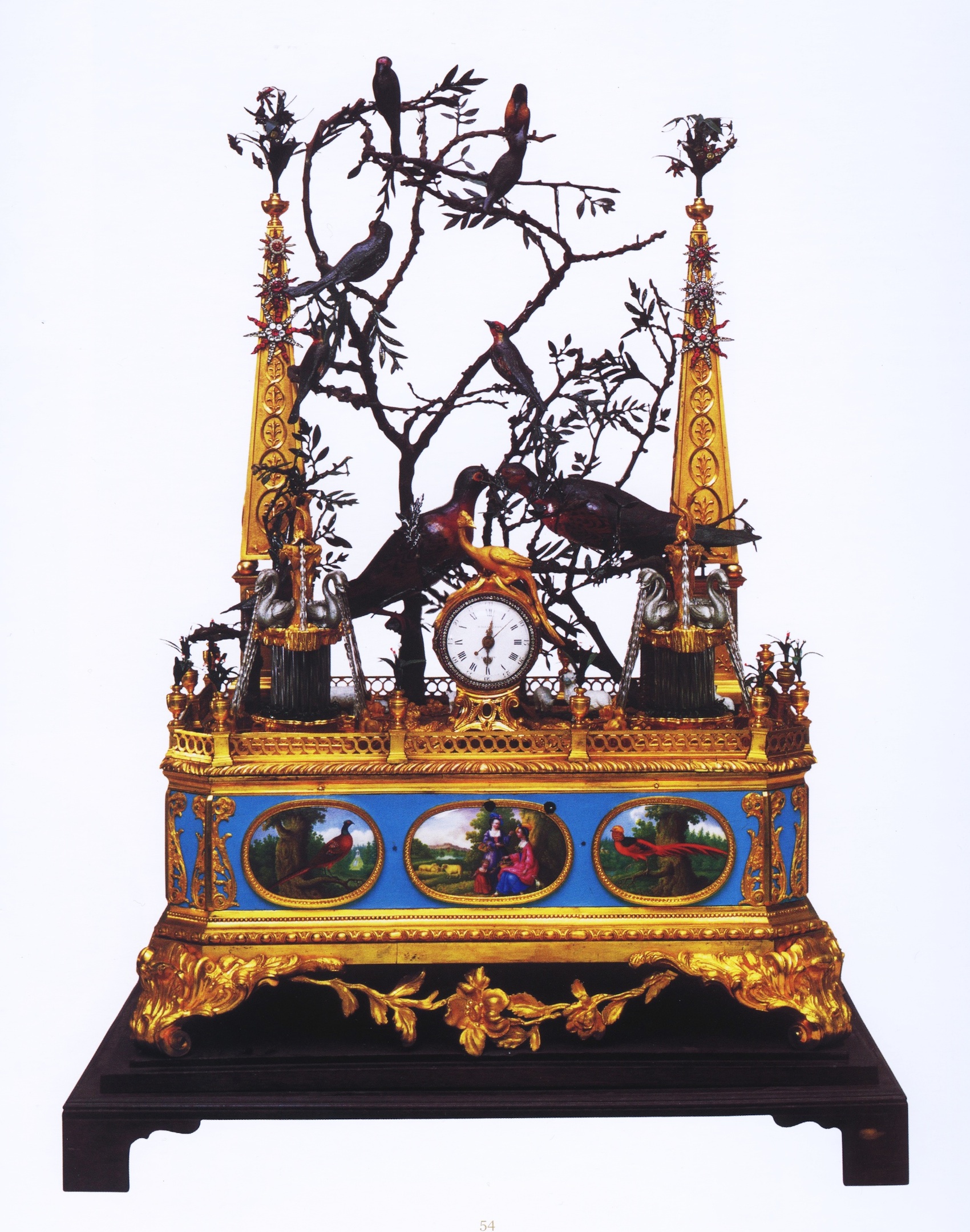
Fig. 13. Joseph Williamson, Automaton clock, c. 1710-1720 109 x 53 x 66 cm. Palace Museum, Beijing. Image Source: Gugong bowuyuan, ed., Gugong zhongbiao, p. 111.
Enthusiasm for mechanical clocks escalated during the High Qing era, especially among its rulers. Whereas Kangxi was fascinated by their technological know-how and Yongzheng (r. 1722-1735) by their utilitarian orientation—which he interpreted in terms of Daoist cyclical consciousness and urgency—Qianlong admired their exquisiteness, ingenuity, and, above all, the “moving playthings” (huodong wanyi 活動玩意) housed therein.[42] All three emperors wrote poems under the title of “Ode to Self-Singing Bell” (Yong ziming zhong 詠自鳴鐘), reflecting their different receptions.[43] Fascinated with the vibrant artifice that emulated living beings, Qianlong wrote in his Ode:
Strange treasures arrive within marine cargoes;
exquisite workmanship surpasses the beauty of fine lotus.
Water and fire gleam without sources;
seconds and minutes secretly change by themselves.
Divine artifice truly exceeds nature;
sounds thrust the turn of the hour.
The singings of the clocks have variants;
music circulates foreign melodies.[44]
Qianlong’s poem elicits some pyrotechnic sensations out of the amazement of artifice and automata. He compares the wonder of the clock to that of the lotus, a traditional cultural icon that was known for its aloof sprouting out of the mud and luminous flowering above ripples. He remarks on the contending illumination and mutation of artificial fire and water, and on the variation of songs.
Reverberations: Empire and Exchange
The emperors’ zests for clocks fostered the establishment of a Clock Manufacture Bureau (Zuozhong Chu 做鐘處) in the Imperial Household Department Workshop.[45] Outside the court, the port city of Canton flourished in mechanical clock manufacture.[46] At the same time, commercial trade and tributary gift-giving consistently targeted clocks and watches.[47] The Hall of Clocks and Watches (Zhongbiao Guan 鐘表館) in the Forbidden City today houses surviving examples of clocks made at the Qing court and in Canton, as well as European clocks. The ones made during Qianlong’s reign were baroque, often representing panoptic paradises, which associated time with the heavenly body and the calendrical cycle under traditional cultural ideals of longevity and opulence. The numerous collections of mechanical clocks up to the Qianlong period, along with Qianlong’s own emphasis on adding various moving playthings, must have marked the interior display of Qing palace spectacles with luminosity, motion, and melody.[48]
A Qianlong-period clock produced at the court, for example, represents a lotus pond contained in a tank (Fig. 15). The tank is made of gilt copper alloy decorated with Canton cloisonné enamel, in which a French clock automechanism is installed. A crystal glass mirror represents the water surface; in the middle of it, a brass ring harnesses seven aigrettes in varied poses. Out of the “water,” lotus stalks shoot lithely, topped with leaves and flowers, all made of enameled metals. The dial is built on the surface of the tank, circled with green and red glass beads; on its left is the switch for the clockwork, while on the right is the switch for the automata. When winding the latter, music rises; the ring revolves to make the aigrettes orbit over the water surface. Meanwhile, the lotus buds blossom, among which the three highest ones reveal figures in the flowers: in the middle is the Queen Mother of the West who sits still, while flanked by the Child of Wealth and White Ape, who devote longevity peaches to her. The scene represents a blissful paradise of eternity and piety. The motifs on the tank’s surface manifest a profusion of ocean waves, mountain peaks, bats, butterflies, and flowers—all symbols of longevity and prosperity. The object’s overall presentation arguably resonates with firework spectacles that had, in turn, emulated floral blooming and figural action, as discussed above. It also integrates the mechanical clock into a lotus setting, the two fine things which Qianlong references in his poem. Thus, it blends the spectacle of “splendid confusion” with a noticeable state of cultural fusion.
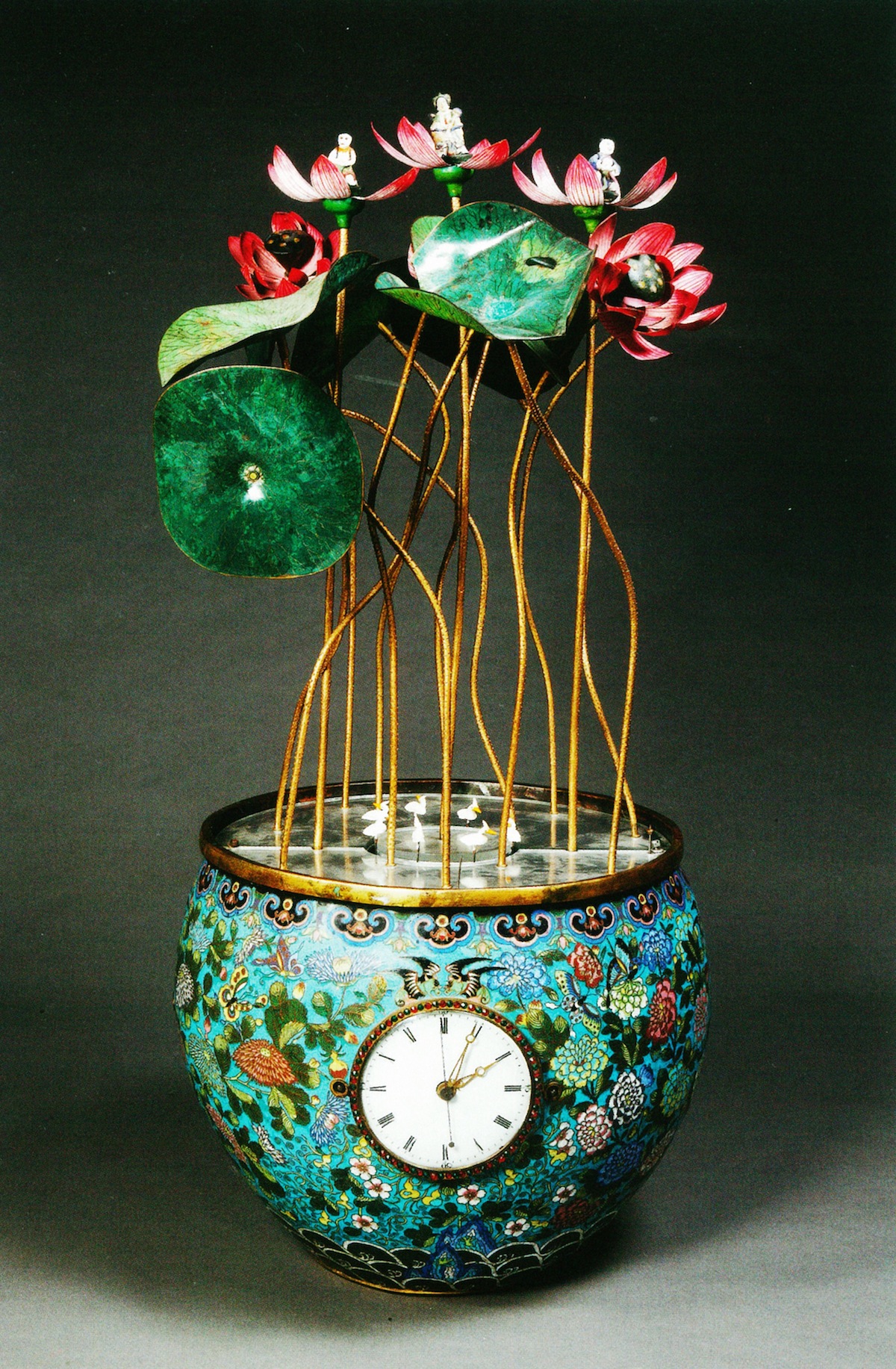
Fig. 15. Imperial Household Department Clock Manufacture Bureau, Automaton Clock in a Planter with Lotus Pond and Daoist Immortals, Qianlong period. 122 x 49 cm (dial diameter 17 cm). Palace Museum, Beijing. Image source: Li Jian et al, Forbidden City: Imperial Treasures from the Palace Museum, Beijing (Richmond: Virginia Museum of Fine Arts, 2014), p. 111.
As Simon Schaffer argues, European export artifacts such as mechanical clocks—as Sino-European “go-betweens”—became “cargo” that embodied the “culture and economy of which they were components.”[49] Automaton clocks consolidated in one instrument a combination of early modern European sciences, technologies, and material mediums that represented power and authority and entered commercial ventures and trade. When they arrived in China, those things packed with and within mechanical clocks were unpacked into various milieux of knowledge production and manufacture. For instance, crystal glass, as one component of a mechanical clock—used on its music box, dial cover, and “water” automata—galvanized the establishment of imperial and local industries and became a much needed product in its own right.[50]
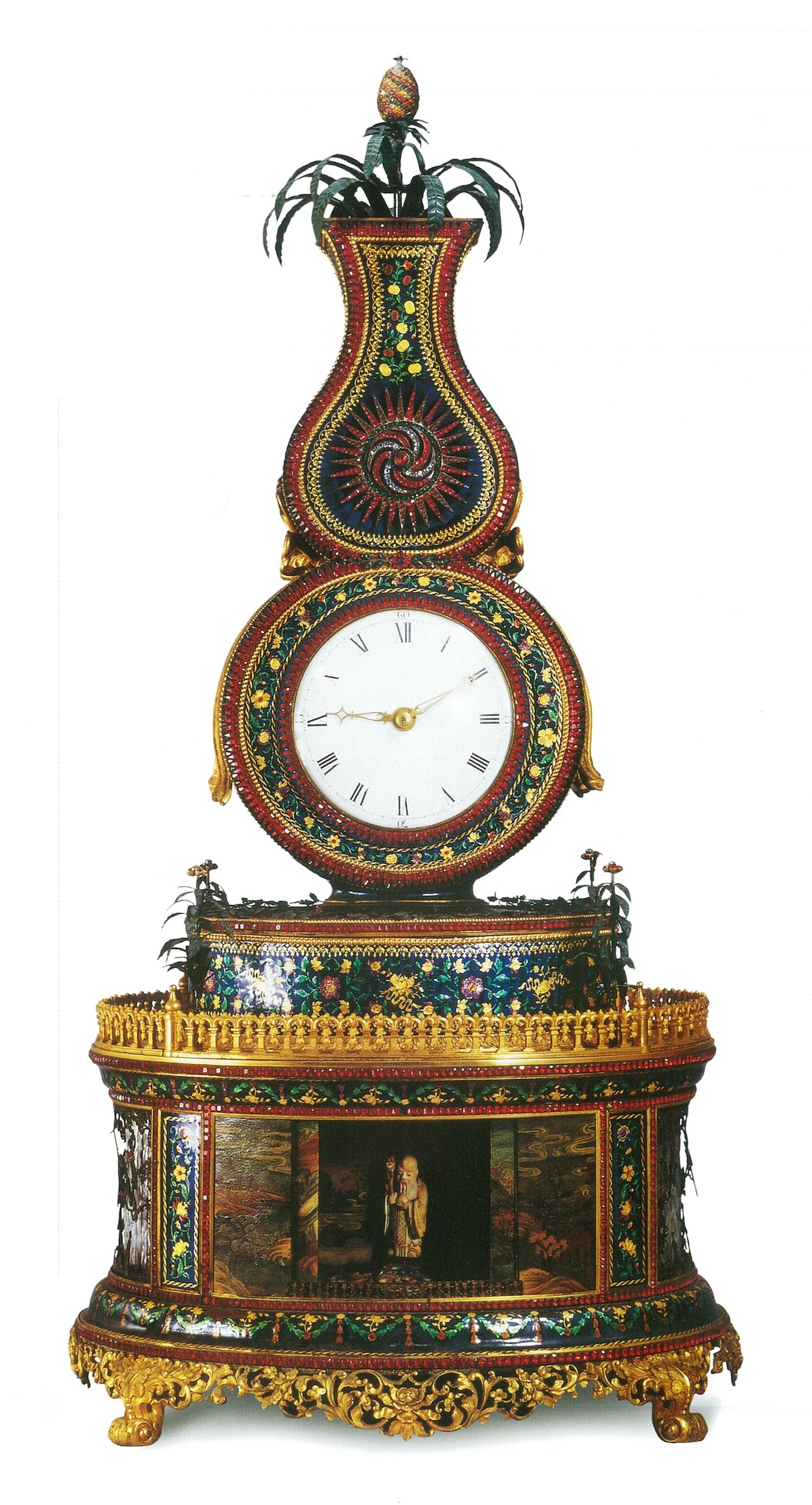
Fig. 16. Canton workshop, Gilded brass automaton clock, Qianlong period. 84 x 41 x 32 cm. Palace Museum, Beijing. Image source: Gugong bowuyuan, ed., Gugong zhongbiao, p. 90.
For Qing emperors, an automaton clock was itself a spectacle, as it encompassed an assemblage of technologies and a proliferation of attention-grabbing activities and signs on a fixed apparatus; it was a spectacle that affirmed the ordering of human and worldly multiplicities.[51] Such a reception hinged on an imperial cosmopolitanism which incorporated novel imports within a mélange of indigenous cultural-historical references, while situating the emperor’s vision and taste at the center of universal concord.[52] The emperor’s all-encompassing and radial vision practiced in the ordering of the empire from the High-Qing court was manifested in the construction, function, and display of automaton clocks. Clocks with firework ornamentation in particular simulated a spectacle of mesmerizing confusion and profusion, while they yoked a fleeting admixture of well synchronized, revolving things.
Both the workings and ornamental schemes of mechanical clocks were translated into Chinese terms, which often revived archaic sources.[53] The imperially- or locally-made mechanical clocks recapitulated cultural themes, symbols, icons, idioms, puns, and metaphors. Those anachronistic or timeless representations aimed to invoke the ancient ideology of harmony among the cosmos, state, and people.[54] Such majestic conceptions of order were declared, for example, in a Canton clock made during the Qianlong period, with a punned idiomatic theme “Universal Blissful Peace” (Sihai shengping 四海昇平, literally “placid vapors rise above four oceans,” with “ping” 瓶-vase punning “ping” 平-peace) (Fig. 16).[55] The imaginaries of such paradisiacal grandeur and harmony are re/presented in Daoist signs as an elixir-gourd rising above oceans. The double-tiered, cylindrical, aquatic and palatial worlds evoke such uplifting forces through the mystic vapors painted on the curtains/doors of the proscenium, the cavernous cascades beside it, and the waves just below the gourd, in addition to the glistening surfaces of indigo enamel that foil the variegated floral patterns. When the switch is wound, all the automata move: the curtains open, showing the Lord of Longevity, who walks in the center of the scene as a lingzhi-fungus, crane, and deer come to meet him. The cascades flow, as if rushing down from the waves above; the waves undulate as if the gourd floated upon them. The bottom half of the gourd contains the dial, while the upper features a firework ornament. A stalk of medicinal pineapple grows out of the gourd. Here, the gourd embraces the firework like an embryo, provoking the beholder to imagine the inchoate origins of gunpowder invention in China which took place in the process of baking elixir. Similarly, the gourd contains the dial as if it represented the primordial, round oneness of cosmogenesis, when time was embryotic in darkness. The cinnabar-like glass beads delineate closures to encompass each domain, and thus unify all things while multiplying the impact of their emanation. Ringing automata like mechanical clocks of this kind, with their centrifugal patterning and luminous optical and symbolic profusions, enact the “universal prospect” of the “wheel-turning king,” as Pamela Kyle Crossley describes in her analysis of the underpinnings of Qianlong rule.[56]
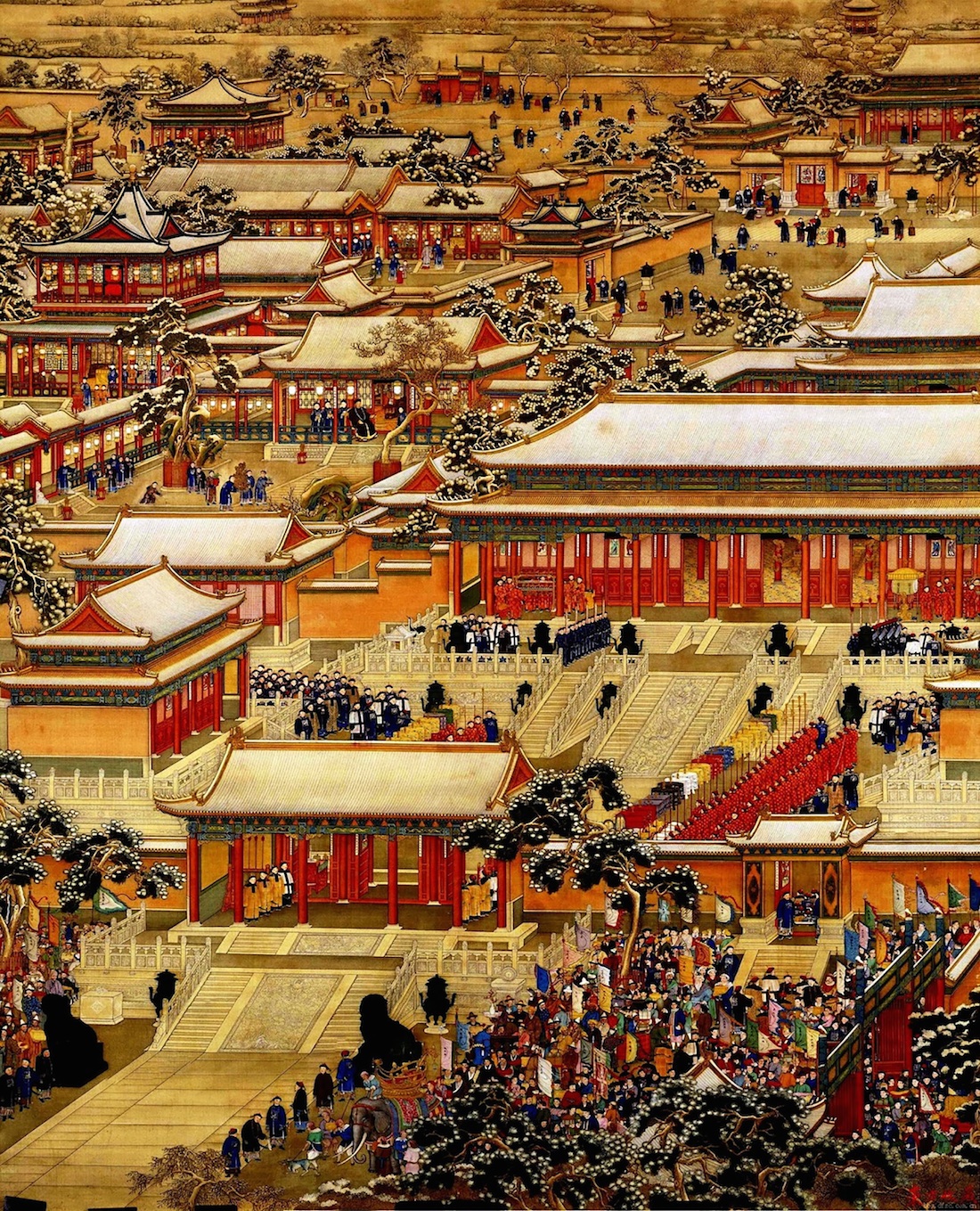
Fig. 17. Yao Wenhan 姚文翰 (active second half of the eighteenth century) and other Qing court artists, Ten-Thousand Tributaries Coming to Court, c. 1761. Hanging scroll, color and ink on silk, 297 x 206.5 cm. Palace Museum, Beijing. Image in the public domain.
These numerous artefactual expressions of ascendance, grandeur, and all-encompassing existence culminated in the painting Ten-Thousand Tributaries Coming to Court (Wanguo lai chao 萬國來朝), commissioned by Qianlong around 1761 (Fig. 17). The painting was made to commemorate an event that occurred on New Year’s Day. The subject invoked an archaic political ideology, harkening back to the incipient formation of sovereign power in ancient China, when lords, vassals, and fiefs gathered to offer congratulations with tributes.[57] Textual records show that the practice of such ceremonial fetes during the Spring Festival can be traced back to the Sui dynasty (581-618) under the martial and pompous Emperor Yang of Sui 隋煬帝 (r. 604-618):
Every New Year’s Day, ten-thousand states come to congratulate the monarch; they stay until the fifteenth day of the first month [the Lantern Festival]. Outside the Duan Gate, within the Jianguo Gate, a span of some eight miles is set up as a performing stage. … Proceed with splendid parades of bonfires, and light torches to illuminate the Heaven and Earth. The magnificent spectacle of countless dramatic plays excels those of all the ancients. Hence, it becomes an annual convention.[58]
Ten-Thousand Tributaries Coming to Court shows Qianlong continuing this practice by staging an imperially cosmopolitan spectacle comprising peoples, objects, animals, and birds representing all states and regions known to the court. In contrast to New Year’s Beginning (Fig. 1), which celebrates the New Year in a private setting at the beginning of Qianlong’s era, this magnanimous spectacle commemorates the same occasion, some two decades later, before a much more public and cross-cultural audience—however a pictorial construct of such an audience it may be.[59] The painting continues and amplifies an order of actions, showcasing the universal authority and legitimacy of the multi-ethnic ruling house and its inclusive empire. Similarly conjuring an ancient theme, it presents the past in the present while also parading distant peoples and things in proximity through a spectacle of actions that seems to transpire simultaneously and on one site.
As in New Year’s Beginning, Sino-European courtly painting methods use orthogonal lines to project a diagonal recession of space, but here along the opposite axis, traversing from the lower-left to the upper-right. That axis separates the emperor’s presence from his officials and visitors. Qianlong, now fifty, sits in a veranda in a backyard in the Forbidden City, surrounded by intimate courtiers and eunuchs; farther, in the anterior yards, consorts and heirs gather around (Fig. 18). Multi-ethnic and multicultural dignitaries gather outside of the Hall of Supreme Harmony (Taihe Dian 太和殿), the grandest ceremonial hall in the palace (Fig. 19). Within the compound of the Hall, court-officials stand in queues. The emperor’s contact with the officials and tributaries is mediated by the bronze tripods installed along the passageways, along with the ascendant dragon reliefs carved on the stone slopes and the two gigantic bronze lions guarding the entrance—all archaic proxies of monarchal presence and symbols of sovereignty.
Kristina Kleutghen has convincingly argued that Qianlong deployed numerous verandas in the palaces as stages of performance, fashioning ubiquitous theatricality at his court. Kleutghen also observes that the Sino-European court style used to visualize the palatial spaces preferred depiction to representation in order to reveal both the outer and inner spaces as much as the pictorial surface/space could allow and would require.[60] Here, instead of sitting in the main Hall, Qianlong is ensconced in a veranda in an annexed yard behind the Hall, as if he expects a performance to commence. His positioning above his visitors visually elevates his presence, as if he is ascending above the Hall, and the architectural complex recessing along an inclined ground acts as a virtual scaffold for him. The sense of mutual beholding between Qianlong and his visitors heightens the theatrical relay and response.
The scene also insinuates a politics of flare by staging the emperor amidst numerous flickering lanterns, as though he appeared from a luminous revelation. Clusters of snowflakes on the pines and snowy roofs resonate with them and spread radiance. The floral sparks of snow are transfused on the pines below, at the bottom of the composition, where crowds of dignitaries congregate. They bring with them a variety of animals and objects as tribute, including a mechanical clock (Fig. 20). Rather than depicting a solemn ritual of reception, the image and its atmosphere represent and present an expectant moment of excitement, a boiling spectacle of anticipation for the contact about to transpire.
At this juncture, Qianlong’s wish to represent empire through multi-ethnic tributaries reflected the waning of an omnipotence that had peaked in the previous decade. Among other things, the completion of the Garden of Round Brightness by 1750 signaled the summit of High-Qing power, which itself presented an all-encompassing space shaped by traditional Chinese geomantic and cosmological layouts with European quarters designed to stage imported and transcultural objects including clocks, fountains, exotic fauna and flora. At the same time, in 1751, Qianlong launched a large project to compile the Qing Imperial Illustrations of Tributaries (Huangqing zhigong tu 皇清職貢圖), which contained various pictures of “Tribute Bearers.”[61] Ten-Thousand Tributaries Coming to Court and its multiple copies, while attempting to assemble the various tributary domains in one spectacle, reverberated with the resplendence of the Universal Monarch to which Qianlong had laid claim. Soon however, this spectacular profusion, like the fireworks that celebrated it, would dissolve into thin air.
Lihong Liu is Assistant Professor of Art History at the University of Rochester
Acknowledgements: I thank Marcia Reed, Senior Curator of the Getty Research Institute Special Collections, for discussing depictions of fireworks with me, Meredith Martin and Noémie Étienne for their editorial endeavors, and the two anonymous reviewers for their helpful comments. All translations are mine unless otherwise noted.
[1] For example, Simon Werrett, Fireworks: Pyrotechnic Arts and Sciences in European History (Chicago: University of Chicago, 2010); and Kevin Salatino, Incendiary Art: The Representation of Fireworks in Early Modern Europe (Los Angeles: The Getty Research Institute, 1997).
[2] For a critical discussion of “spectacle” as a set of techniques for managing attention and as a fixation of heterogeneity, see Jonathan Crary, “Spectacle, Attention, Counter-Memory,” October 50 (1989), 96-107.
[3] For a detailed study of paintings of this subject, see Kristina Kleutghen, Imperial Illusions: Crossing Pictorial Boundaries in the Qing Palaces (Seattle: University of Washington, 2014), 106-112.
[4] Chen Pao-chen 陳葆真 identifies Qianlong’s three sons in the painting. See Chen, Qianlong huangdi de jiating shenghuo yu neixin shijie 乾隆皇帝的家庭生活與內心世界 (Taipei: Rock Publishing International, 2014), 62. See also Kleutghen’s elaborate analysis on this royal family event and its signification in Imperial Illusions, 111.
[5] Shijing. Xiaoya. Tingliao 詩經.小雅.庭燎 (dated to the ninth-eighth centuries BCE) describes such a practice as “to gather a hundred items and wrap them in a bundle” 以物百枚并而纏束之. By the Tang dynasty, it was common to smear oil over bundles of pine branches, weeds, and bamboos and burn them. Reprinted in Mao Shi zheng yi 毛詩正義 (Hong Kong: Zhonghua shuju, 1964), vol. 3, 912.
[6] Around 600 CE, Li’s contemporary Sun Simiao 孫思邈 (581-682), known as the “Medicine King,” was the first to combine saltpeter, sulphur, and charcoal to produce a drug—or “elixir” (danyao 丹藥); see Guojia chubanshe bianshen bu 國家出版社編審部 eds., Renjian qiao yi 人間巧藝 (Taipei: Heluo tushu chubanshe, 1978), 49. On gunpowder, see Joseph Needham et al., Science and Civilization in China. Volume 5: Chemistry and Chemical Technology. Part 7: Military Technology: The Gunpowder Epic (Cambridge: Cambridge University Press, 1986), 112.
[7] For the military use of gunpowder in China, see Tonio Andrade, Gunpowder Age: China, Military Innovation, and the Rise of the West in World History (Princeton: Princeton University Press, 2016), esp. 15-28.
[8] For a comprehensive study of the development of firecrackers and fireworks, see Needham, Science and Civilization in China. Volume 5, 127-146.
[9] For the use of gunpowder in the development of firecrackers, see Noboru Okada 岡田登, Chūgoku kayakushi: kokushoku kayaku no hatsumei to bakuchiku no hensen 中国火薬史 : 黒色火薬の発明と爆竹の変遷 (Tōkyō: Kyūko Shoin, 2006).
[10] Andrade, Gunpowder Age, 33-165; William Hardy McNeill, The Age of Gunpowder Empires, 1450-1800 (Washington, D.C.: The American Historical Association, 1989).
[11] Werrett, Fireworks, esp. 1-70.
[12] For a succinct account of fireworks in Britain and its relation with Chinese fireworks, see Brenda Buchanan, “Making Fireworks,” in Gunpowder Plots: A Celebration of 400 Years of Bonfire Night (London: Penguin Books, 2005), 145-188.
[13] See, for example, David Cannadine, “The Fifth of November Remembered and Forgotten,” in Gunpowder Plot, 1-8.
[14] Salatino, Incendiary Art, 23.
[15] Werrett, Fireworks, 33-34.
[16] Edmund Burke, A Philosophical Enquiry into the Origin of Our Ideas of the Sublime and Beautiful, Part I, Section xii. Also cited in Salatino, Incendiary Art, 10.
[17] Salatino, Incendiary Art, 100 n24.
[18] Jean-Louis de Cahuzac, “Feux d’artifice,” in Denis Diderot, Encyclopédie (Paris: Briasson, 1751-72; reprint, Stuttgart-Bad Cannstatt: Frommann, 1966), 6.
[19] Theodor W. Adorno, Aesthetic Theory (Minneapolis: University of Minnesota Press, 1997), 81.
[20] Salatino, Incendiary Art, 11-12.
[21] For an account of the pervasive existence of pyropolitics across time and space, especially on metaphorical uses of fires and flames in political rhetoric, see Michael Marder, Pyropolitics: When the World is Ablaze (Lanham, MD: Rowman & Littlefield International, 2014).
[22] Joseph Needham, Science & Civilization in China. Volume 7: The Gunpowder Epic (Cambridge: Cambridge University Press, 1987), 142.
[23] Original: 用生鐵粉雜硝磺灰等為玩具。其名不一。有聲者曰響炮;高起者曰起火;起火中帶炮連聲者曰三級浪。不響不起旋繞地上者曰地老鼠。築打有虛實,分兩有多寡,因而有花草人物等形者,曰花兒,名幾百種。其別以泥函者曰砂鍋兒;以紙函者曰花筒;以筐函者曰花盆。總之曰煙火云。 Shen Bang 沈榜, Yuanshu zaji 宛署雜記, juan 18, in Beiping defang yanjiu congkan 北平地方研究叢刊, vol. 2 (Reprint, Taipei: Guting shuwu, 1970).
[24] Original: 食頃,火光遠近齊著,如蟄雷奮地,飛電掣空。此時月色天光,俱為煙氣所蔽。觀者神移目眩,震撼動搖,不能自主。 Zha Shenxing 查慎行, Renhai ji 人海記 (Reprint, Beijing: Beijing Airusheng shuzihua jishu yanjiu zhongxin, 2009), juan 2, 58.
[25] Original: 火繩紛繞,儼如飛電。俄聞萬炮齊作,轟雷震天,逾刻乃已。Xiaohengxiangshi Zhuren 小橫香室主人, Qingchao yeshi daguan 清朝野史大觀 (Shanghai: Zhonghua shuju, 1915), 87.
[26] Original: 近則精巧畢出,眾技爭鳴。試燈之暇,豪富家輒以此為殿,列架廣陌,街填巷呼。俄而機燈朗達,花火爭明,流星上飛,地鼠旁竄。 Zhao Xuemin 趙學敏, Huoxi lue 火戲畧 (Reprint, Tianjin: Tianjin tushuguan guji bu, 1986), preface.
[27] Original: 足見太平之景象,熙之鳳規也。 Zhao, Huoxi lue, preface.
[28] Catherine Pagani, “Eastern Magnificence & European Ingenuity”: Clocks of Late Imperial China (Ann Arbor: University of Michigan Press, 2001), 137.
[29] Otto Mayr, Authority, Liberty & Automatic Machinery in Early Modern Europe (Baltimore and London: The Johns Hopkins University Press, 1986), 6.
[30] Gerhard Dohrn-van Rossum, History of the Hour: Clocks and Modern Temporal Orders, trans. Thomas Dunlop (Chicago: The University of Chicago Press, 1996), esp. 217-288.
[31] Mayr, Authority, Liberty & Automatic Machinery, 115-121.
[32] Simon Schaffer, “Enlightened Automata,” in The Sciences in Enlightened Europe, William Clark, Jan Golinski, and Simon Schaffer, eds (Chicago: University of Chicago Press, 1999), 126-165.
[33] Schaffer, “Enlightened Automata,” 141. Schaffer cites Jean-Marie Apostolidès, Le roi-machine: spectacle et politique au temps de Louis XIV (Paris: Minuit, 1981), 156.
[34] Schaffer, “Enlightened Automata,” 158.
[35] Original: 每小時報時後,即奏樂一曲,各時不同,最後則如萬炮齊鳴,聲亦漸降,若向遠處退卻, 終於不聞。 Feng Chengjun 馮承鈞 trans., Zai hua yesuhui liezhuan ji shumu 在華耶穌會列傳及書目 (Beijing: Zhonghua shuju, 1995), 257, from Louis Pfister (1833-1891), Notices biographiques et bibliographiques sur les jésuites de l’ancienne mission de Chine (1552-1773) (San Francisco: Chinese Materials Center, 1932), 254.
[36] Noel Golvers, The “Astronomia Europea” of Ferdinand Verbiest, S.J. (Dillingen, 1687): Text, Translation, Notes and Commentaries (Nettetal: Steyler Verl., 1993), 127-128.
[37] Yunlu 允祿 (1695-1767) et al. compiled, Huangchao liqi tu 皇朝禮器圖, juan 3, in Sikuquanshu 四庫全書. In 1809, the Chinese horologist Xu Zhaojun 徐朝俊 wrote the technical treatise Ziming Zhong biaotu fa 自鳴鐘表圖法, reprinted in Bo Shuren 薄樹人, ed., Zhongguo kexue jishu dianji tonghui 中國科學技術典籍通彙 (Zhengzhou: Henan jiaoyu chubanshe, 1996), vol. 6, 1021-1032. Xu examines the fittings and technologies of dis/assembling clocks. In the preface, he criticizes frivolous moving playthings, which reflects the generally negative attitudes towards the ornate automaton clocks under the rule of Emperor Jiaqing 嘉慶 (r. 1796-1820).
[38] Schall von Bell went on to be employed by the court as an astronomer, assisting with the reformation of the Chinese calendar. He also orally transmitted the methods of using gunpowder in firearms and artilleries, which the Chinese scholar Jiao Xu 焦勖 recorded in Outlines of Fire Projectiles (Huogong qiyao 火攻挈要) in 1643 (Reprint, Shanghai: Shangwu yinshu guan, 1936). For Schall von Bell, see, for example, Benjamin A. Elman, On Their Own Terms: Science in China, 1550-1900 (Cambridge, MA: Harvard University Press, 2005), 134-139.
[39] Pagani, Eastern Magnificence & European Ingenuity, 1-26.
[40] Pagani, Eastern Magnificence & European Ingenuity, 7. For Su Song’s astronomical clock, see Joseph Needham et al., Heavenly Clockwork: The Great Astronomical Clocks of Medieval China (Cambridge: Cambridge University Press, 1960), esp. 48-59.
[41] Liu Yuefang 劉月芳, “Qinggong Zuozhong Chu” 清宮做鐘處, Gonggong bowuyuan yuankan 故宮博物院院刊 4 (1989), 50-51.
[42] Li Sufen 李素芬, “Qingchao huangdi yu xiyang zhongbiao” 清朝皇帝與西洋鐘表, Zijing Cheng 紫禁城 2 (2006), 100-104.
[43] Gugong bowuyuan 故宮博物院 ed., Gugong zhongbiao 故宮鐘表 (Beijing: Zijingcheng chubanshe, 2004), 16.
[44] Original: 奇珍來海舶,精製勝宮蓮。水火明非藉,秒分暗自遷。天工誠巧奪,時次以音傳。…鐘鳴別體備,樂律異方宣。 Reprinted in Qing Gaozong yuzhi shiwen quanji 清高宗禦製詩文全集 (Beijing: Renmin daxue chubanshe, 1993), vol. 5, 694.
[45] Liu, “Qinggong Zuozhong Chu,” 49-55.
[46] Huang Qingchang 黃慶昌, “Qingdai Guangzhou zhizao de xishi zhongbiao jiqi lishi beijing tanxi” 清代廣州制造的西式鐘表及其歷史背景探析, Nanfang wenwu 南方文物 3 (2011), 190-195.
[47] José Maria Braga, “A Seller of ‘Sing-Songs’: A Chapter in the Foreign Trade of China and Macao,” Journal of Oriental Studies 6:1-2 (1967), 61-108.
[48] An incomplete survey shows that throughout Qianlong’s reign, approximately 3000 pieces reached the court as tribute. Gugong zhongbiao, 23.
[49] Simon Schaffer, “Instruments and Cargo in the China Trade,” History of Science 44 (2006), 218.
[50] Lihong Liu, “Vitreous Views: Materiality and Mediality of Glass in Qing China through a Transcultural Prism,” Getty Research Journal 8 (2016), 17-38.
[51] For a discussion on the correlation between surveillance and spectacle, see Crary, “Spectacle, Attention, Counter-Memory,” 105.
[52] Tamara T. Chin explains that what we call “cosmopolitanism” invokes the ethics of empire, as opposed to its initial meaning of world citizen in ancient Greek philosophy. See Chin, “What Is Imperial Cosmopolitanism? Revisting Kosmopolitēs and Mundanus,” in Cosmopolitanism and Empire: Universal Rulers, Local Elites, and Cultural Integration in the Ancient Near East and Mediterranean, Myles Lavan, Richard E. Payne, and John Weisweiler, eds (Oxford: Oxford University Press, 2016), 129-151.
[53] Elman, On Their Own Terms, 233-280.
[54] For a study of the Manchu-Qing reference to traditional Chinese literary, symbolical, and religious sources, see Richard J. Smith, The Qing Dynasty and Traditional Chinese Culture (Lanham, MD: Rowman & Littlefield Publishers, 2015), esp. 169-237.
[55] This phrase appears, for example, in Zhang Yuezhi’s 張說之 (667-730) “Da Tang si fengshan song” 大唐祀封禪頌, in Zhang Yuezhi wenji 張說之文集, juan 12: 1 (Reprint, Shanghai: Shanghai shudian,1989).
[56] Pamela Kyle Crossley, A Translucent Mirror: History and Identity in Qing Imperial Ideology (Berkeley and Los Angeles: University of California Press, 1999), 217-336. Qianlong claimed to incarnate the “Wheel-Turning King” (cakra-vartī-rāja 轉輪王), a Buddha (or the universal Dharma King) who turns the Dharma wheel. For Qianlong’s practice of Buddhism and its cultural associations, see Patricia Berger, Empire of Emptiness: Buddhist Art and Political Authority (Honolulu: University of Hawai’i Press, 2003), esp. 34-62.
[57] Such ceremony is said to be held by the legendary ancient ruler Yu the Great 大禹 (2200-2101 BCE), as recorded in Zuozhuan 左傳: “When Yu gathered the princes together at Mount Tu, ten thousand domains came with jade and silk” 禹合諸侯於塗山,執玉帛者萬國。Text and translation from Stephen W. Durrant, Wai-yee Li, and David Schaberg, Zuo Tradition: Commentary on the “Spring and Autumn Annals” (Seattle: University of Washington Press, 2016), 1874-1875.
[58] Original: 每歲正月,萬國來朝,留至十五日。於端門外,建國門內,綿亙八里,列為戲場…。大列炬火,光燭天地,百戲之盛,振古無比。自是每年以為常焉。 Wei Zheng 魏徵 (580-643), Sui shu 隋書, juan 15 (Reprint, Shanghai: Zhonghua shuju, 1936), 381.
[59] Lai Yu-Chih 賴毓芝 discusses the constructedness of the pictorial scene—based on both real events and contemporary tributary images—in “Gouzhu lixiang diguo: Zhigong tu yu Wanguo lai chao tu de zhizuo” 構築理想帝國: 職貢圖與萬國來朝圖的制作, Zijing Cheng 237 (2014), 56-69.
[60] Kristina Kleutghen, “Staging Europe: Theatricality and Painting at the Chinese Imperial Court,” Studies in Eighteenth-Century Culture 42 (2012), 81-102.
[61] Lai Yu-Chih, “Tuxiang diguo: Qianlong chao Zhigong tu de zhizuo yu didu chengxian” 圖像帝國: 乾隆朝 “職貢圖” 的製作與帝都呈現, Zhongyang yanjiuyuan jindaishi yanjiusuo jikan 中央研究院近代史研究所研究季刊 75 (2012), 1-76.
Cite this article as: Lihong Liu, “Pyrotechnic Profusion: Fireworks, Spectacles, and Automata in Time,” Journal18, Issue 3 Lifelike (Spring 2017), https://www.journal18.org/1550. DOI: 10.30610/3.2017.4
Licence: CC BY-NC
Journal18 is published under a Creative Commons CC BY-NC International 4.0 license. Use of any content published in Journal18 must be for non-commercial purposes and appropriate credit must be given to the author of the content. Details for appropriate citation appear above.

